HTC RAPH700 Pocket PC Phone User Manual Manual Part 1
HTC Corporation Pocket PC Phone Manual Part 1
HTC >
Contents
- 1. Manual Part 1
- 2. Manual Part 2
Manual Part 1

1%"
6TFS.BOVBM

2
Please Read Before Proceeding
THE BATTERY IS NOT CHARGED WHEN YOU TAKE IT OUT OF THE BOX.
DO NOT REMOVE THE BATTERY PACK WHEN THE DEVICE IS CHARGING.
YOUR WARRANTY IS INVALIDATED IF YOU OPEN OR TAMPER WITH THE DEVICE’S OUTER
CASING.
PRIVACY RESTRICTIONS
Some countries require full disclosure of recorded telephone conversations, and stipulate that you must
inform the person with whom you are speaking that the conversation is being recorded. Always obey the
relevant laws and regulations of your country when using the recording feature of your PDA Phone.
INTELLECTUAL PROPERTY RIGHT INFORMATION
Copyright © 2008 HTC Corporation. All Rights Reserved.
, , , ExtUSB, and HTC Care are trademarks and/or service marks of HTC Corporation.
Microsoft, MS-DOS, Windows, Windows NT, Windows Server, Windows Mobile, Windows XP, Windows Vista,
ActiveSync, Windows Mobile Device Center, Internet Explorer, MSN, Hotmail, Windows Live, Outlook, Excel,
PowerPoint, Word, OneNote and Windows Media are either registered trademarks or trademarks of Microsoft
Corporation in the United States and/or other countries.
Bluetooth and the Bluetooth logo are trademarks owned by Bluetooth SIG, Inc.
Java, J2ME and all other Java-based marks are trademarks or registered trademarks of Sun Microsystems, Inc.
in the United States and other countries.
Copyright © 2008, Adobe Systems Incorporated. All Rights Reserved.
Opera® Mobile from Opera Software ASA. Copyright 1995-2008 Opera Software ASA. All Rights Reserved.
Google is a registered trademark of Google, Inc. in the United States and other countries.
YouTube is a trademark of Google, Inc.
Sprite Backup is a trademark or service mark of Sprite Software.
Copyright © 2001-2008, Spb Software House. All Rights Reserved.
Copyright © 2008, Esmertec AG. All Rights Reserved.
Copyright © 2003-2008, ArcSoft, Inc. and its licensors. All Rights Reserved. ArcSoft and the ArcSoft logo are
registered trademarks of ArcSoft, Inc. in the United States and/or other countries.
Copyright © 2004-2008, Ilium Software, Inc. All Rights Reserved.
All other company, product and service names mentioned herein are trademarks, registered trademarks or
service marks of their respective owners.
HTC shall not be liable for technical or editorial errors or omissions contained herein, nor for incidental or
consequential damages resulting from furnishing this material. The information is provided “as is” without
warranty of any kind and is subject to change without notice. HTC also reserves the right to revise the content
of this document at any time without prior notice.
No part of this document may be reproduced or transmitted in any form or by any means, electronic or
mechanical, including photocopying, recording or storing in a retrieval system, or translated into any
language in any form without prior written permission of HTC.
3
Disclaimers
THE WEATHER INFORMATION, DATA AND DOCUMENTATION ARE PROVIDED “AS IS” AND WITHOUT WARRANTY
OR TECHNICAL SUPPORT OF ANY KIND FROM HTC. TO THE MAXIMUM EXTENT PERMITTED BY APPLICABLE
LAW, HTC AND ITS AFFILIATES expressly disclaim any and all representations and warranties, express or
implied, arising by law or otherwise, regarding the Weather Information, Data, Documentation, or any other
Products and services, including without limitation any express or implied warranty of merchantability,
express or implied warranty of fitness for a particular purpose, non-infringement, quality, accuracy,
completeness, effectiveness, reliability, usefulness, that the Weather Information, Data and/or Documentation
will be error-free, or implied warranties arising from course of dealing or course of performance.
Without limiting the foregoing, it is further understood that HTC and its Providers are not responsible for Your
use or misuse of the Weather Information, Data and/or Documentation or the results from such use. HTC and
its Providers make no express or implied warranties, guarantees or affirmations that weather information
will occur or has occurred as the reports, forecasts, data, or information state, represent or depict and it shall
have no responsibility or liability whatsoever to any person or entity, parties and non-parties alike, for any
inconsistency, inaccuracy, or omission for weather or events predicted or depicted, reported, occurring or
occurred. WITHOUT LIMITING THE GENERALITY OF THE FOREGOING, YOU ACKNOWLEDGE THAT THE WEATHER
INFORMATION, DATA AND/OR DOCUMENTATION MAY INCLUDE INACCURACIES AND YOU WILL USE COMMON
SENSE AND FOLLOW STANDARD SAFETY PRECAUTIONS IN CONNECTION WITH THE USE OF THE WEATHER
INFORMATION, DATA OR DOCUMENTATION.
Limitation of Damages
TO THE MAXIMUM EXTENT PERMITTED BY APPLICABLE LAW, IN NO EVENT SHALL HTC OR ITS PROVIDERS
BE LIABLE TO USER OR ANY THIRD PARTY FOR ANY INDIRECT, SPECIAL, CONSEQUENTIAL, INCIDENTAL OR
PUNITIVE DAMAGES OF ANY KIND, IN CONTRACT OR TORT, INCLUDING, BUT NOT LIMITED TO, INJURY, LOSS OF
REVENUE, LOSS OF GOODWILL, LOSS OF BUSINESS OPPORTUNITY, LOSS OF DATA, AND/OR LOSS OF PROFITS
ARISING OUT OF, OR RELATED TO, IN ANY MANNER, OR THE DELIVERY, PERFORMANCE OR NONPERFORMANCE
OF OBLIGATIONS, OR USE OF THE WEATHER INFORMATION, DATA OR DOCUMENTATION HEREUNDER
REGARDLESS OF THE FORESEEABILITY THEREOF.
Important Health Information and Safety Precautions
When using this product, the safety precautions below must be taken to avoid possible legal liabilities and
damages.
Retain and follow all product safety and operating instructions. Observe all warnings in the operating
instructions on the product.
To reduce the risk of bodily injury, electric shock, fire, and damage to the equipment, observe the following
precautions.
ELECTRICAL SAFETY
This product is intended for use when supplied with power from the designated battery or power supply unit.
Other usage may be dangerous and will invalidate any approval given to this product.
SAFETY PRECAUTIONS FOR PROPER GROUNDING INSTALLATION
CAUTION: Connecting to an improperly grounded equipment can result in an electric shock to your device.
This product equipped with a USB Cable for connecting with desktop or notebook computer. Be sure your
computer is properly grounded (earthed) before connecting this product to the computer. The power supply
cord of a desktop or notebook computer has an equipment-grounding conductor and a grounding plug. The
plug must be plugged into an appropriate outlet which is properly installed and grounded in accordance with
all local codes and ordinances.
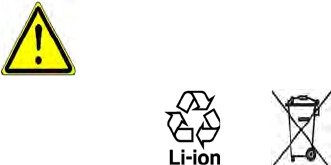
4
SAFETY PRECAUTIONS FOR POWER SUPPLY UNIT
Use the correct external power source
A product should be operated only from the type of power source indicated on the electrical ratings
label. If you are not sure of the type of power source required, consult your authorized service provider
or local power company. For a product that operates from battery power or other sources, refer to the
operating instructions that are included with the product.
Handle battery packs carefully
This product contains a Li-ion battery. There is a risk of fire and burns if the battery pack is handled
improperly. Do not attempt to open or service the battery pack. Do not disassemble, crush, puncture,
short external contacts or circuits, dispose of in fire or water, or expose a battery pack to temperatures
higher than 60˚C (140˚F).
WARNING: Danger of explosion if battery is incorrectly replaced. To reduce risk of fire or burns, do not
disassemble, crush, puncture, short external contacts, expose to temperature above 60° C (140° F), or
dispose of in fire or water. Replace only with specified batteries. Recycle or dispose of used batteries
according to the local regulations or reference guide supplied with your product.
Take extra precautions
Keep the battery or device dry and away from water or any liquid as it may cause a short circuit.
Keep metal objects away so they don’t come in contact with the battery or its connectors as it may
lead to short circuit during operation.
Do not use a battery that appears damaged, deformed, or discolored, or the one that has any rust
on its casing, overheats, or emits a foul odor.
Always keep the battery out of the reach of babies and small children, to avoid swallowing of the
battery. Consult the doctor immediately if the battery is swallowed.
Avoid dropping the phone or battery. If the phone or battery is dropped, especially on a hard
surface, and the user suspect damage, take it to a service centre for inspection.
If the battery leaks:
Do not allow the leaking fluid to come in contact with skin or clothing. If already in contact,
flush the affected area immediately with clean water and seek medical advice.
Do not allow the leaking fluid to come in contact with eyes. If already in contact, DO NOT rub;
rinse with clean water immediately and seek medical advice.
Take extra precautions to keep a leaking battery away from fire as there is a danger of ignition
or explosion.
SAFETY PRECAUTIONS FOR DIRECT SUNLIGHT
Keep this product away from excessive moisture and extreme temperatures. Do not leave the product or
its battery inside a vehicle or in places where the temperature may exceed 60°C (140°F), such as on a car
dashboard, window sill, or behind a glass that is exposed to direct sunlight or strong ultraviolet light for
extended periods of time. This may damage the product, overheat the battery, or pose a risk to the vehicle.
PREVENTION OF HEARING LOSS
CAUTION: Permanent hearing loss may occur if earphones or headphones are used at high volume for prolonged periods
of time.
SAFETY IN AIRCRAFT
Due to the possible interference caused by this product to an aircraft’s navigation system and its
communications network, using this device’s phone function on board an airplane is against the law in most
countries. If you want to use this device when on board an aircraft, remember to turn off your phone by
switching to Airplane Mode.
•
•
•
•
•
•
•
•
•
•
•
•
5
ENVIRONMENT RESTRICTIONS
Do not use this product in gas stations, fuel depots, chemical plants or where blasting operations are in
progress, or in potentially explosive atmospheres such as fuelling areas, fuel storehouses, below deck
on boats, chemical plants, fuel or chemical transfer or storage facilities, and areas where the air contains
chemicals or particles, such as grain, dust, or metal powders. Please be aware that sparks in such areas could
cause an explosion or fire resulting in bodily injury or even death.
EXPLOSIVE ATMOSPHERES
When in any area with a potentially explosive atmosphere or where flammable materials exist, the product
should be turned off and the user should obey all signs and instructions. Sparks in such areas could cause
an explosion or fire resulting in bodily injury or even death. Users are advised not to use the equipment at
refueling points such as service or gas stations, and are reminded of the need to observe restrictions on the
use of radio equipment in fuel depots, chemical plants, or where blasting operations are in progress. Areas
with a potentially explosive atmosphere are often, but not always, clearly marked. These include fueling areas,
below deck on boats, fuel or chemical transfer or storage facilities, and areas where the air contains chemicals
or particles, such as grain, dust, or metal powders.
ROAD SAFETY
Vehicle drivers in motion are not permitted to use telephony services with handheld devices, except in the
case of emergency. In some countries, using hands-free devices as an alternative is allowed.
SAFETY PRECAUTIONS FOR RF EXPOSURE
Avoid using your phone near metal structures (for example, the steel frame of a building).
Avoid using your phone near strong electromagnetic sources, such as microwave ovens, sound
speakers, TV and radio.
Use only original manufacturer-approved accessories, or accessories that do not contain any metal.
Use of non-original manufacturer-approved accessories may violate your local RF exposure guidelines
and should be avoided.
INTERFERENCE WITH MEDICAL EQUIPMENT FUNCTIONS
This product may cause medical equipment to malfunction. The use of this device is forbidden in most
hospitals and medical clinics.
If you use any other personal medical device, consult the manufacturer of your device to determine if they
are adequately shielded from external RF energy. Your physician may be able to assist you in obtaining this
information.
Turn your phone OFF in health care facilities when any regulations posted in these areas instruct you to do so.
Hospitals or health care facilities may be using equipment that could be sensitive to external RF energy.
HEARING AIDS
Some digital wireless phones may interfere with some hearing aids. In the event of such interference, you may
want to consult your service provider, or call the customer service line to discuss alternatives.
NONIONIZING RADIATION
Your device has an internal antenna. This product should be operated in its normal-use position to ensure
the radiative performance and safety of the interference. As with other mobile radio transmitting equipment,
users are advised that for satisfactory operation of the equipment and for the safety of personnel, it is
recommended that no part of the human body be allowed to come too close to the antenna during operation
of the equipment.
Use only the supplied integral antenna. Use of unauthorized or modified antennas may impair call quality and
damage the phone, causing loss of performance and SAR levels exceeding the recommended limits as well as
result in non-compliance with local regulatory requirements in your country.
To assure optimal phone performance and ensure human exposure to RF energy is within the guidelines set
forth in the relevant standards, always use your device only in its normal-use position. Do not touch or hold
the antenna area unnecessarily when placing or receiving a phone call. Contact with the antenna area may
•
•
•
•
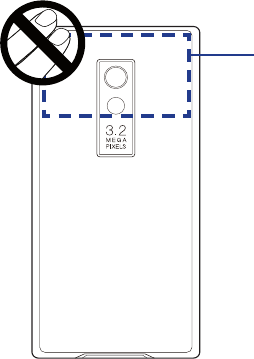
6
impair call quality and cause your device to operate at a higher power level than needed. Avoiding contact
with the antenna area when the phone is IN USE optimizes the antenna performance and the battery life.
Antenna location
General Precautions
• Avoid applying excessive pressure to the device
Do not put heavy objects or apply excessive pressure on the device to prevent damaging the device or
distorting the touch screen display. Also avoid carrying the device inside your pocket for extensive lengths of
time.
• Heed service markings
Except as explained elsewhere in the Operating or Service documentation, do not service any product
yourself. Service needed on components inside the device should be done by an authorized service
technician or provider.
• Damage requiring service
Unplug the product from the electrical outlet and refer servicing to an authorized service technician or
provider under the following conditions:
Liquid has been spilled or an object has fallen into the product.
The product has been exposed to rain or water.
The product has been dropped or damaged.
There are noticeable signs of overheating.
The product does not operate normally when you follow the operating instructions.
• Avoid hot areas
The product should be placed away from heat sources such as radiators, heat registers, stoves, or other
products (including amplifiers) that produce heat.
• Avoid wet areas
Never use the product in a wet location.
• Avoid using your device after a dramatic change in temperature
When you move your device between environments with very different temperature and/or humidity ranges,
condensation may form on or within the device. To avoid damaging the device, allow sufficient time for the
moisture to evaporate before using the device.
NOTICE: When taking the device from low-temperature conditions into a warmer environment or from high-temperature
conditions into a cooler environment, allow the device to acclimate to room temperature before turning on
power.
• Avoid pushing objects into product
Never push objects of any kind into cabinet slots or other openings in the product. Slots and openings are
provided for ventilation. These openings must not be blocked or covered.
• Mounting accessories
•
•
•
•
•
7
Do not use the product on an unstable table, cart, stand, tripod, or bracket. Any mounting of the product
should follow the manufacturer’s instructions, and should use a mounting accessory recommended by the
manufacturer.
• Avoid unstable mounting
Do not place the product with an unstable base.
• Use product with approved equipment
This product should be used only with personal computers and options identified as suitable for use with
your equipment.
• Adjust the volume
Turn down the volume before using headphones or other audio devices.
• Cleaning
Unplug the product from the wall outlet before cleaning. Do not use liquid cleaners or aerosol cleaners. Use a
damp cloth for cleaning, but NEVER use water to clean the LCD screen.
8
Contents
Chapter 1 Getting Started 15
1.1 Getting to Know Your Touch Phone and Accessories .............................. 16
Top panel ...................................................................................................................................................16
Front panel ................................................................................................................................................16
Bottom panel ...........................................................................................................................................16
Left panel ...................................................................................................................................................17
Back panel .................................................................................................................................................17
Right panel ................................................................................................................................................17
Accessories ................................................................................................................................................17
1.2 Installing the Battery ................................................................................. 18
Battery ........................................................................................................................................................18
1.3 Charging the battery ................................................................................. 19
1.4 Starting Up ................................................................................................. 20
Turn your device on and off ................................................................................................................20
Switch to Sleep mode when not in use ..........................................................................................20
1.5 Navigating Your Device ............................................................................. 20
Finger-touch control .............................................................................................................................20
Stylus ...........................................................................................................................................................21
Navigation Control .................................................................................................................................21
1.6 Home Screen .............................................................................................. 22
1.7 Status Icons ................................................................................................ 22
1.8 Start Menu .................................................................................................. 24
1.9 Quick Menu ................................................................................................. 24
1.10 LED Alerts .................................................................................................. 25
1.11 Adjusting the Volume ............................................................................... 25
1.12 Using your Device as a USB Drive ............................................................ 26
Chapter 2 Using Phone Features 27
2.1 Using the Phone ......................................................................................... 28
The Phone screen ...................................................................................................................................28
2.2 Voice Call .................................................................................................... 28
Make a call .................................................................................................................................................28
Answer a call.............................................................................................................................................29
End a call ...................................................................................................................................................30
Call History ................................................................................................................................................30
Speed Dial .................................................................................................................................................30
Turn the phone function on and off ................................................................................................31
9
2.3 Smart Dial ................................................................................................... 31
Make a call or send a text message using Smart Dial ................................................................32
Chapter 3 TouchFLO™ 3D 33
3.1 About TouchFLO™ 3D ................................................................................. 34
3.2 Using the TouchFLO 3D Home Screen ...................................................... 34
Home ..........................................................................................................................................................35
People .........................................................................................................................................................36
Messages ...................................................................................................................................................37
Mail ..............................................................................................................................................................37
Photos and Videos ..................................................................................................................................38
Music ...........................................................................................................................................................39
Internet .......................................................................................................................................................41
Weather ......................................................................................................................................................41
Settings ......................................................................................................................................................42
Programs....................................................................................................................................................42
3.3 Finger Gestures .......................................................................................... 43
Finger scrolling ........................................................................................................................................43
Finger zooming .......................................................................................................................................43
Finger panning ........................................................................................................................................43
Chapter 4 Entering Text 45
4.1 Selecting an Input Method ....................................................................... 46
4.2 Using the Full QWERTY .............................................................................. 46
4.3 Using the Compact QWERTY ..................................................................... 47
4.4 Using the Phone Keypad ........................................................................... 48
4.5 Using Multitap and T9 Modes ................................................................... 48
Multitap mode .........................................................................................................................................48
T9 mode .....................................................................................................................................................48
4.6 Using Numeric and Symbol Mode ............................................................ 49
4.7 Using Block Recognizer ............................................................................. 50
4.8 Using Letter Recognizer ............................................................................ 50
4.9 Using Transcriber ....................................................................................... 50
Chapter 5 Synchronizing Information With Your Computer 53
5.1 About Synchronization ............................................................................. 54
Ways to synchronize ..............................................................................................................................54
5.2 Setting Up Windows Mobile® Device Center on Windows Vista® ........... 54
Set up synchronization in Windows Mobile Device Center ....................................................54
Use Windows Mobile Device Center ................................................................................................55
5.3 Setting Up ActiveSync® on Windows XP® ................................................. 55
10
Install ActiveSync ....................................................................................................................................55
Set up synchronization in ActiveSync .............................................................................................55
5.4 Synchronizing With Your Computer ......................................................... 56
Start and stop synchronization .........................................................................................................56
Change which information is synchronized .................................................................................56
Troubleshoot sync connection problem ........................................................................................56
5.5 Synchronizing via Bluetooth .................................................................... 57
5.6 Synchronizing Music and Video ................................................................ 57
Chapter 6 Exchanging Messages 59
6.1 Messaging .................................................................................................. 60
6.2 Text Messages ............................................................................................ 60
Create a new text message .................................................................................................................60
Compose and send a text message .................................................................................................61
Manage text messages .........................................................................................................................61
6.3 Types of E-mail Accounts ........................................................................... 62
Set up your device to synchronize Outlook e-mail with the computer..............................62
Add an e-mail account .........................................................................................................................62
6.4 E-mail Setup Wizard ................................................................................... 62
Set up an Internet e-mail account ....................................................................................................62
Set up a custom domain e-mail ........................................................................................................64
6.5 Using E-mail................................................................................................ 64
Create a new e-mail message ............................................................................................................64
Compose and send an e-mail ............................................................................................................64
Filter the Inbox message list ...............................................................................................................65
View and reply to messages ...............................................................................................................65
Synchronize e-mails...............................................................................................................................66
Customize e-mail settings ...................................................................................................................66
Chapter 7 Working With Company E-mails and Meeting
Appointments 69
7.1 Synchronizing with the Exchange Server ................................................ 70
Set up an Exchange Server connection ..........................................................................................70
Start synchronization ............................................................................................................................70
7.2 Working With Company E-mails ............................................................... 71
Automatic synchronization through Direct Push .......................................................................71
Scheduled synchronization ................................................................................................................71
Instant download through Fetch Mail ............................................................................................71
Search for e-mails on the Exchange Server...................................................................................72
Flag your messages ...............................................................................................................................72
7.3 Managing Meeting Requests .................................................................... 73
Out-of-office auto-reply .......................................................................................................................73
11
7.4 Finding Contacts in the Company Directory ........................................... 74
Chapter 8 Internet 75
8.1 Ways of Connecting to the Internet .......................................................... 76
Wi-Fi .............................................................................................................................................................76
Dial-up ........................................................................................................................................................78
8.2 Starting a Data Connection ....................................................................... 78
8.3 Using Opera Mobile™ ................................................................................ 79
View Web pages ......................................................................................................................................80
Opera Mobile menu ..............................................................................................................................80
8.4 Using YouTube™ ......................................................................................... 81
Browse for videos ...................................................................................................................................81
Watching videos .....................................................................................................................................82
Bookmarks ................................................................................................................................................83
History ........................................................................................................................................................83
8.5 Using Windows Live™ ................................................................................ 84
Set up Windows Live™ ..........................................................................................................................84
The Windows Live™ interface .............................................................................................................84
Windows Live™ Messenger .................................................................................................................85
Launch Messenger and sign in ..........................................................................................................85
Add Windows Live™ contacts .............................................................................................................85
8.6 Using Your Device As a Modem (Wireless Modem) ................................. 86
Activate your device as a modem ....................................................................................................86
Add your device as a modem to your notebook ........................................................................86
Create a modem dial-up connection ..............................................................................................88
Dial up and connect to the Internet ................................................................................................90
8.7 Using RSS Hub ............................................................................................ 91
Subscribe to and organize news channels ....................................................................................91
View and organize headlines .............................................................................................................92
View the news summary ......................................................................................................................92
Chapter 9 Bluetooth 95
9.1 Bluetooth Modes ....................................................................................... 96
9.2 Bluetooth Partnerships ............................................................................. 96
9.3 Connecting a Bluetooth Hands-free or Stereo Headset ......................... 97
9.4 Beaming Information Using Bluetooth .................................................... 97
9.5 Bluetooth Explorer and Bluetooth File Sharing ...................................... 98
9.6 Printing Files via Bluetooth ....................................................................... 99
Chapter 10 Navigating on the Road 101
10.1 Guidelines and Preparation for Using GPS ........................................... 102
12
10.2 Downloading Satellite Data via QuickGPS ........................................... 103
Download options .............................................................................................................................. 103
Chapter 11 Experiencing Multimedia 105
11.1 Taking Photos and Videos ...................................................................... 106
Capture modes ..................................................................................................................................... 106
Camera controls ................................................................................................................................... 107
On-screen controls and indicators ................................................................................................ 107
Menu Panel ............................................................................................................................................ 108
Zooming ................................................................................................................................................. 109
The Review screen ............................................................................................................................... 110
Advanced Options .............................................................................................................................. 110
11.2 Viewing Photos and Videos Using Album ............................................. 112
Select a photo or video to view ...................................................................................................... 112
View an image ...................................................................................................................................... 113
Play back video ..................................................................................................................................... 115
Close Album .......................................................................................................................................... 115
11.3 Using Windows Media® Player Mobile .................................................. 115
About the controls .............................................................................................................................. 116
About the screens and menus ........................................................................................................ 116
Synchronize video and audio files................................................................................................. 116
Play media .............................................................................................................................................. 117
Playlists .................................................................................................................................................... 118
Troubleshooting .................................................................................................................................. 118
11.4 Using Audio Booster ............................................................................... 118
11.5 Using MP3 Trimmer ................................................................................ 119
Chapter 12 Programs on your Device 121
12.1 Programs on your Device ....................................................................... 122
Programs in the Start Menu ............................................................................................................. 122
Programs screen .................................................................................................................................. 122
12.2 Adding and Removing Programs .......................................................... 123
12.3 Adobe® Reader® LE ................................................................................. 124
12.4 Calendar .................................................................................................. 124
Create appointments ......................................................................................................................... 124
View appointments ............................................................................................................................ 125
Send appointments ............................................................................................................................ 125
12.5 Contacts ................................................................................................... 126
Add new contacts ................................................................................................................................ 126
Organize and search contacts ......................................................................................................... 127
Share contact information ............................................................................................................... 127
12.6 Comm Manager....................................................................................... 128
13
12.7 Microsoft® Office Mobile ........................................................................ 128
12.8 Notes ........................................................................................................ 129
12.9 Tasks......................................................................................................... 130
12.10 Voice Recorder ...................................................................................... 131
12.11 ZIP .......................................................................................................... 132
12.12 Sprite Backup ........................................................................................ 133
Chapter 13 Managing Your Device 135
13.1 Copying and Managing Files ................................................................. 136
13.2 Settings on your Device ......................................................................... 137
Personal tab ........................................................................................................................................... 137
System tab ............................................................................................................................................. 137
Connections tab ................................................................................................................................... 138
13.3 Changing Basic Settings ........................................................................ 138
Date and time ....................................................................................................................................... 138
Regional settings ................................................................................................................................. 139
Display settings .................................................................................................................................... 139
Device name .......................................................................................................................................... 139
Ringer settings ...................................................................................................................................... 139
Alarms and notifications ................................................................................................................... 140
Phone services ...................................................................................................................................... 140
13.4 Using Task Manager................................................................................ 141
13.5 Protecting Your Device ........................................................................... 142
Protect your device with a password ........................................................................................... 142
13.6 Managing Memory ................................................................................. 143
13.7 Resetting Your Device ............................................................................. 143
Soft reset ................................................................................................................................................. 143
Hard reset ............................................................................................................................................... 144
Clear Storage ......................................................................................................................................... 144
13.8 Windows Update ..................................................................................... 145
13.9 Battery Saving Tips ................................................................................. 146
Appendix 147
A.1 Specifications ........................................................................................... 148
A.2 Regulatory Notices .................................................................................. 149
Index 157
14

Chapter 1
Getting Started
1.1 Getting to Know Your Touch Phone
and Accessories
1.2 Installing the Battery
1.3 Charging the Battery
1.4 Starting Up
1.5 Navigating Your Device
1.6 Home Screen
1.7 Status Icons
1.8 Start Menu
1.9 Quick Menu
1.10 LED Alerts
1.11 Adjusting the Volume
1.12 Using your Device as a USB Drive
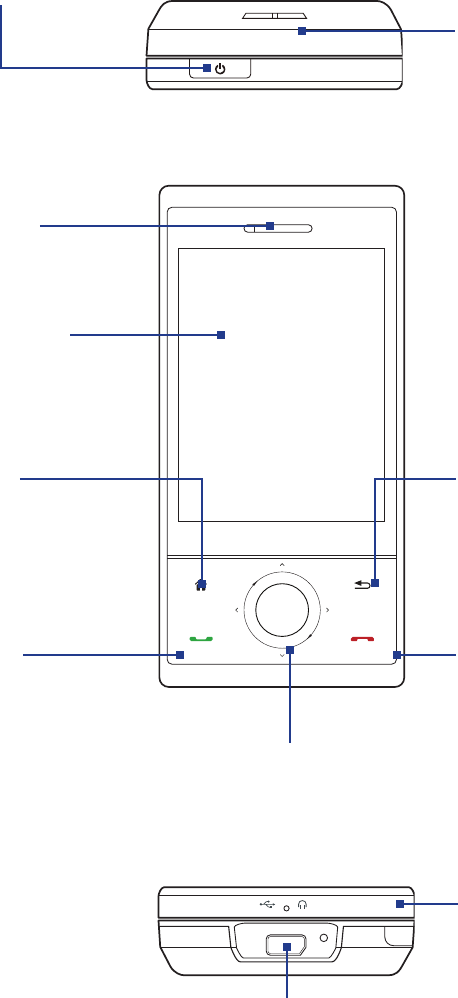
16 Getting Started
1.1 Getting to Know Your Touch Phone and Accessories
Top panel
POWER
Press to turn off the display temporarily. To turn off
the power, press and hold for about 5 seconds.
For more information, see “Starting Up” in this chapter.
Speaker
Front panel
Earpiece
Listen to a phone call
from here.
Touch Screen
HOME
Press to return to the
Home screen.
See Chapter 3 for details.
BACK
Press to return to
the previous screen.
Navigation Control
See “Touch-sensitive navigation control”
later in this chapter for details.
TALK/SEND
Press to answer an incoming
call or dial a number.
During a call, press and hold
to toggle the speakerphone
on and off.
•
•
END
Press to end a call or return to
the Home screen.
Press and hold to lock the
device. (See “Long Press End Key”
under “Settings on your Device”
in Chapter 13 for details.)
•
•
Bottom panel
Sync Connector/Earphone Jack
Connect the supplied USB cable to synchronize information or plug in the
AC adapter to recharge the battery. You can also connect the supplied USB
stereo headset for hands-free conversation or for listening to audio media.
Microphone
Note When using the four buttons — HOME, BACK, TALK/SEND, and END — and the Navigation Control, please observe
the following precautions:
• Make sure to press on the icons of the four buttons for the best accuracy. When pressing on the Navigation
Control, make sure to press the outer areas near the ENTER button for directional control.
• For best results, press with your fingertip. Do not wear gloves.
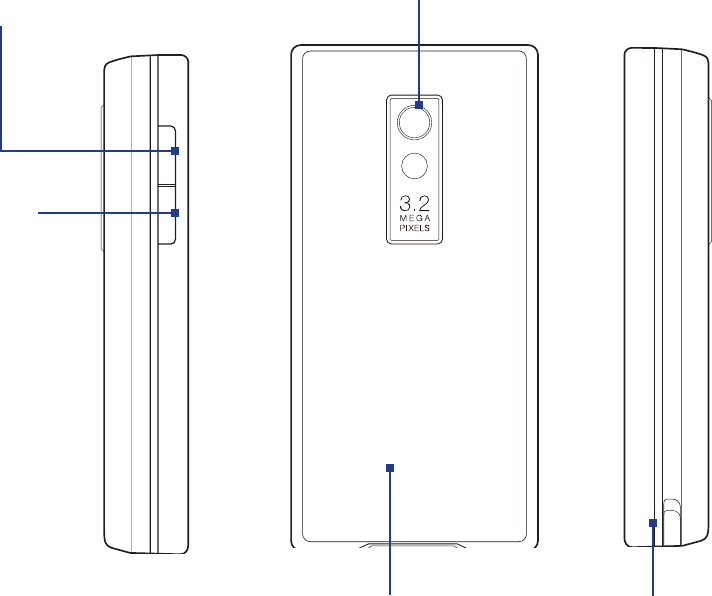
Getting Started 17
Left panel Back panel Right panel
Back Cover
Push the back cover upward
to remove it.
3.2 Megapixel Camera
See “Taking Photos and Videos”
in Chapter 11 for details.
Accessories
The product package includes the following items and accessories:
Battery
AC adapter
Screen protector
Stereo headset
USB sync cable
Multifunction audio cable
Quick Start Guide
Getting Started and Application discs
Pouch
Extra stylus
•
•
•
•
•
•
•
•
•
•
VOLUME UP
During a call or when playing
music, press this button to increase
the volume.
VOLUME DOWN
During a call or when
playing music, press
this button to lower the
volume.
Stylus
(See “Stylus” in this
chapter for details.)

18 Getting Started
1.2 Installing the Battery
Always turn off your device before installing or replacing the battery. You also need to remove the back cover
before you can install these components.
To remove the back cover
1. Make sure your device is turned off.
2. Hold the device with both hands and the front panel facing
down.
3. Push the back cover up with your thumb until it disengages
from the device and then slide it up to remove.
Battery
Your device comes with a rechargeable Lithium-ion or Lithium-ion polymer battery and is designed to use
only manufacturer-specified original batteries and accessories. Battery performance depends on many
factors, including network configuration, signal strength, the temperature of the environment in which you
operate your device, the features and/or settings you select and use, items attached to connecting ports, and
your voice, data, and other program usage patterns.
Battery life estimates (approximations):
Standby time: Up to 375 hours
Talk time: Up to 250 minutes
Note Battery life is subject to network and phone usage.
Warning! To reduce risk of fire or burns:
• Do not attempt to open, disassemble, or service the battery pack.
• Do not crush, puncture, short external contacts, or dispose of in fire or water.
• Do not expose to temperatures above 60oC (140oF).
• Replace only with the battery pack designated for this product.
• Recycle or dispose of used battery as stipulated by local regulations.
To install the battery
1. Align the battery’s exposed copper contacts with the
battery connectors inside the battery compartment.
2. Insert the contact’s side of the battery first and then gently
push the battery into place.
3. Replace the back cover.
Battery grip
To remove the battery
1. Make sure your device is turned off.
2. Remove the back cover.
3. The top right side of the battery has a protruding grip.
Lift the protruding grip to remove the battery.
•
•
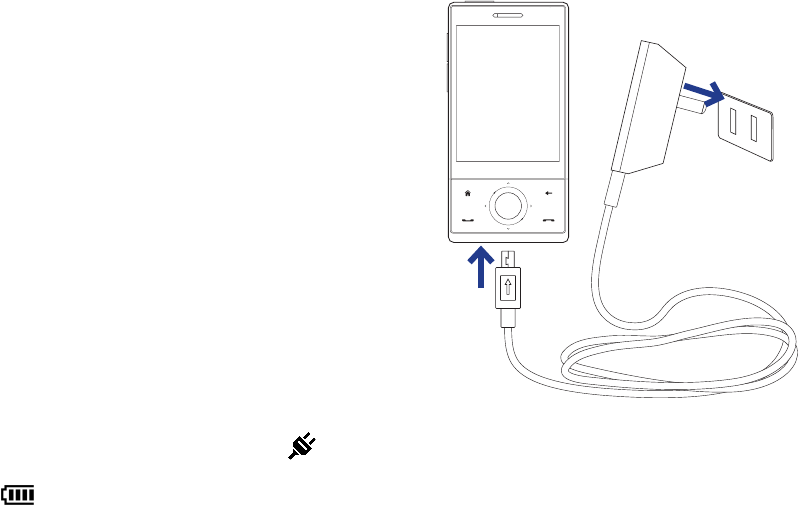
Getting Started 19
1.3 Charging the Battery
New batteries are shipped partially charged. Before you start using your device, it is recommended that you
install and charge the battery. Some batteries perform best after several full charge/discharge cycles.
To charge the battery
1. Connect the USB connector of the AC adapter to the
sync connector on your device.
2. Plug in the AC adapter to an electrical outlet to start
charging the battery.
Note Only the AC adapter and USB sync cable provided with your
device must be used to charge the device.
1
2
Charging is indicated by a “breathing” white light around the Navigation Control. As the battery is being
charged while the power is on, a charging icon ( ) also appears in the title bar of the Home screen.
After the battery has been fully charged, the Navigation Control LED shows a solid white light and a full
battery icon ( ) appears in the title bar of the Home screen.
For more information about the Navigation Control LED, see “LED Alerts” in this chapter.
Warning! • Do not remove the battery from the device while you are charging it using the AC or car adapter.
• As a safety precaution, the battery stops charging when it overheats.
20 Getting Started
1.4 Starting Up
After installing and charging the battery, you can now power on and start using your device.
Turn your device on and off
To turn on the power
1. Press and hold the POWER button for a few seconds.
2. When you turn on your device for the first time, a Quick Start Wizard guides you to set up regional
settings, date and time, and password. For more information about these settings, see Chapter 13.
After the Quick Start Wizard finishes, the device installs customization settings, then restarts.
Note After the device restarts, you may be prompted to set up an e-mail account. For instructions on how to set up an
e-mail account, see Chapter 6.
To turn off the power
1. Press and hold the POWER button for a few seconds.
2. Tap Yes when a message prompts you to choose whether or not to turn off the device completely.
Switch to Sleep mode when not in use
Press and immediately release the POWER button to turn off the display temporarily and switch your device
to Sleep mode. Sleep mode suspends your device to a low power state while the display is off in order to save
battery power.
Your device automatically goes into Sleep mode when you leave the device idle after a certain period of time.
You will still be able to receive messages and calls while your device is in Sleep mode. Pressing the POWER
button again or incoming calls/messages will wake up your device.
1.5 Navigating Your Device
There are different ways you can navigate and interact with the interface of your device.
Finger-touch control
A quick and easy way to interact with the home screen and the whole interface of your device is by touch.
Basically, the following are the types of actions, called finger gestures, you would do when interacting with
your device:
Touch or tap
When selecting items on the screen, such as the Home screen tabs, Start menu, programs and settings icons,
and large on-screen buttons, simply touch them with your finger. Apply some pressure with your finger pad
when touching an item on the screen.
Tapping means to touch lightly and quickly with your finger pad or fingertip. On screens that display smaller-
size items, you can more accurately select an item by tapping it with your fingertip.
Swipe
To swipe means to drag your finger vertically or horizontally across the screen. The following are some
instances when you would use swiping:
Flipping on the Home screen
Swipe your finger vertically to flip through favorite contacts, messages, music albums, photos, and
more. For more information, see “Using the TouchFLO 3D Home Screen” in Chapter 3.
Scrolling
When browsing the contacts list, web pages, documents, and certain selection lists on the Home screen
(such as the All Programs list), slowly swipe your finger vertically across the screen to scroll. This allows
you to scroll by page and to view the content or available selections as you scroll.
The direction of swiping resembles the way you move a printed document as you are reading it. For
detailed instructions, see “Finger scrolling” in Chapter 3.
•
•
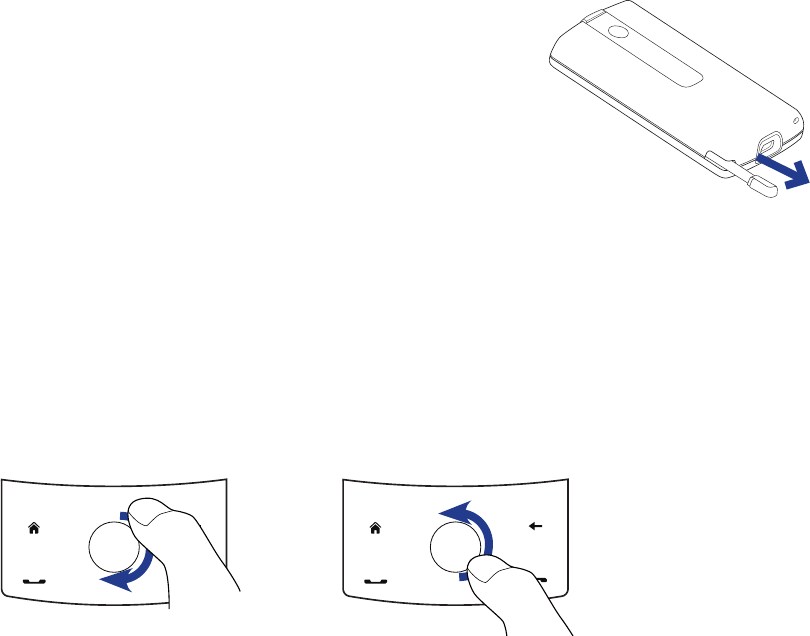
Getting Started 21
Slide
Sliding on the touch screen also involves dragging with your finger, but you need to press and hold your
finger with some pressure before you start to drag. While dragging, do not release your finger until you have
reached the target position.
The following are some instances when you would use sliding:
Switching between Home screen tabs
Slide your finger left and right to switch between the Home screen tabs. For more information, see
“Using the TouchFLO 3D Home screen“ in Chapter 3.
Advancing playback
In players that have a progress bar, such as the Home screen’s Music tab and Windows Media® Player
Mobile, slide your finger horizontally on their progress bar to advance forward or move backward in the
music or video you are playing.
For more information about the Home screen’s Music tab, see “Music” in Chapter 3.
For more information about Windows Media® Player Mobile, see “Using Windows Media® Player Mobile” in
Chapter 11.
Flick
Flicking the screen is similar to swiping, except that you need to swipe your finger in light, quicker strokes.
This finger gesture is always in a vertical direction, such as when flicking the contacts list. See “Finger scrolling”
in Chapter 3 for details.
Finger zooming and panning
In programs such as Album and Opera Mobile, you can use finger gestures when zooming and panning. See
Chapter 3, 8 and 11 for details.
Stylus
You can use the stylus to navigate and interact with the touch
screen. To use the stylus, pull it out from the stylus compartment
at the bottom of the right panel of your device. If the backlight
is off, removing the stylus automatically turns the backlight back
on.
The stylus is magnetic and sticks to the side when held close
to the device. This prevents you from accidentally losing or
misplacing the stylus.
Basically, you tap with the stylus to open programs and select items on the screen, and you tap and hold on
the screen to open a shortcut menu. You can also use the stylus the same way as what you do with finger
gestures, such as swiping, sliding and flicking on the screen.
Navigation Control
On the home screen and in many programs on your device, you can use the Navigation Control for directional
control. Press the directional arrows to navigate up, down, left, and right on the screen. When an item has
been selected on the screen, press the ENTER button (the center button) to confirm your selection.
The Navigation Control is also touch sensitive and can be used for zooming. Slide your finger clockwise
around the Navigation Control to zoom in, counterclockwise to zoom out.
Sliding your finger
counterclockwise
Sliding your finger clockwise
•
•
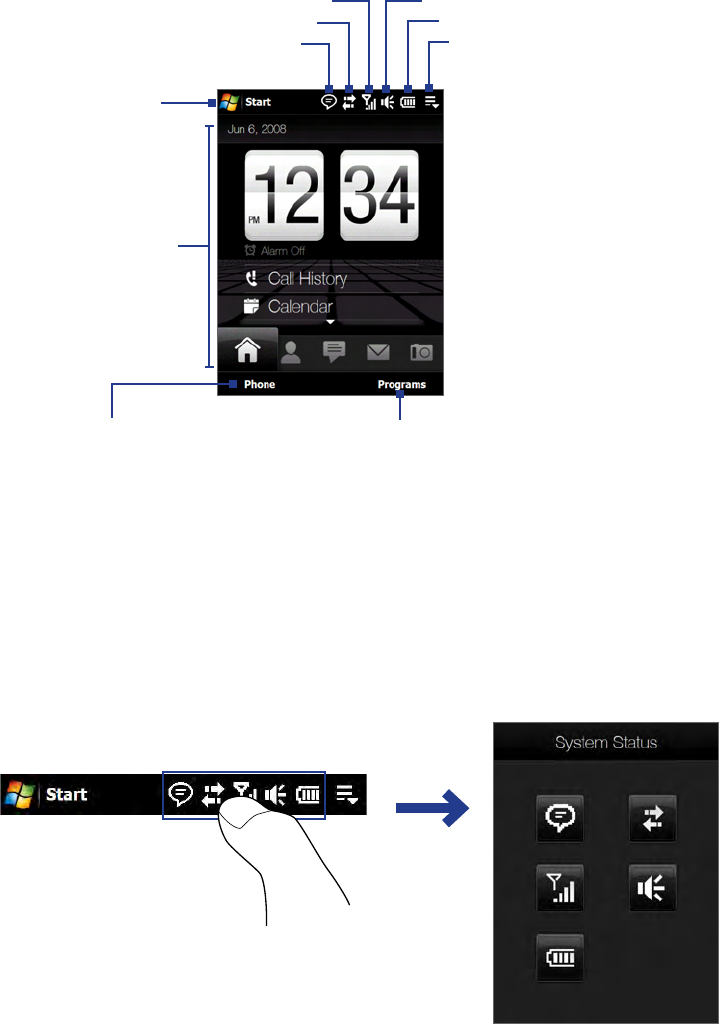
22 Getting Started
The following programs allow you to use the Navigation Control for zooming:
Album•Opera Mobile•
Camera•Word Mobile and Excel Mobile•
Tip If you purchase and install GPS navigation software on your device, you can also use the Navigation Control for
zooming in the GPS software.
On the Home screen’s Music tab, you can advance forward in the music you are playing by sliding clockwise
around the Navigation Control. To move backward in the music, slide counterclockwise. See “Music” in Chapter
3 for details.
1.6 Home Screen
The default home screen of the device is the TouchFLO™ 3D Home screen which allows finger-touch access to
the most important functions such as contacts, text messages, e-mail, Internet, and more.
Start menu
Notification
Signal strength Adjust volume
Battery status
TouchFLO 3D
Home screen
Connection status
Open the Phone screen
(See Chapter 2 for details)
Go to the Programs tab to
access favorite programs
Quick menu
For more information about using the TouchFLO 3D Home screen, see Chapter 3.
1.7 Status Icons
When you touch or tap the icon area of the title bar, the System Status screen opens and displays larger status
icons so you can touch them with your finger more easily and accurately.
Tip The System Status screen can be disabled in TouchFLO settings. See “Settings on your Device” in Chapter 13 for
details.
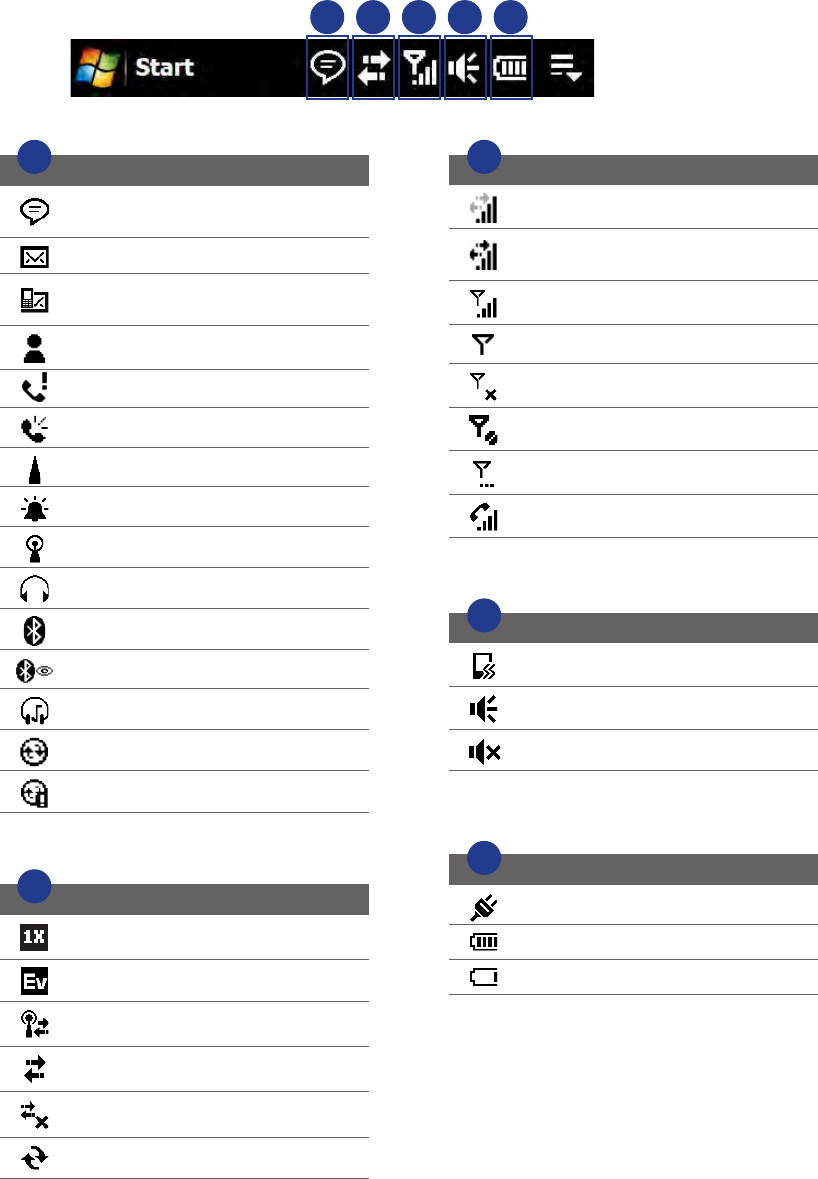
Getting Started 23
The following are some of the status icons that you may see on the device.
12345
Icons that appear in this area
Battery charging
Battery full
Battery very low
Icons that appear in this area
Vibrate mode
Sound on
Sound off
Icons that appear in this area
Data connection is active but idle
Data connection is active and
transmitting data
Maximum signal strength
No signal
Phone is turned off
No phone service
Searching for phone service
Voice call in progress
Icons that appear in this area
1xRTT available
EVDO available
Connected to a wireless network
Connection is active
Connection is not active
Synchronization in progress
Icons that appear in this area
Multiple notifications; tap the icon to
view all
New e-mail messages
New text messages;
SMS notification of voice mail
New Windows Live™ message
Missed call
Speakerphone on
Roaming
Alarm
Other wireless network(s) detected
Wired headset connected
Bluetooth on
Bluetooth visible mode on
Bluetooth stereo headset connected
ActiveSync notification
Synchronization error
1
2
3
4
5
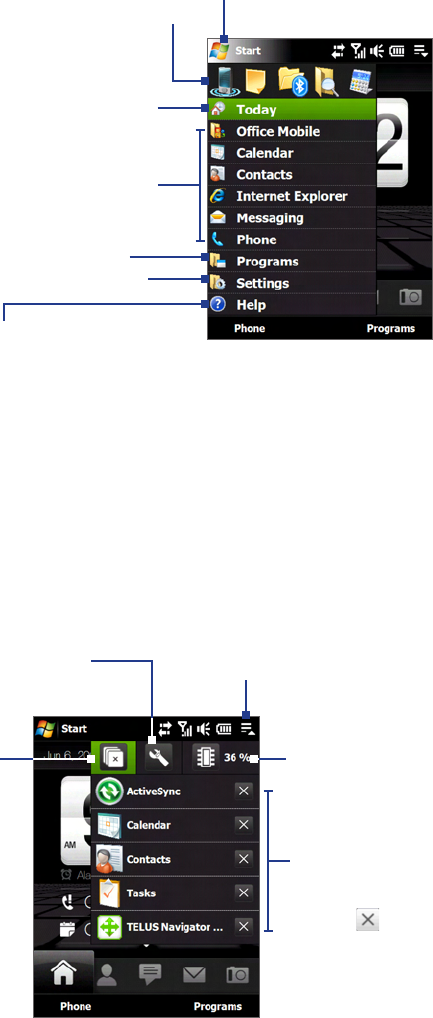
24 Getting Started
1.8 Start Menu
The Start menu, which can be opened from the top left corner of the screen, gives you access to all the
programs and settings of your Windows Mobile-powered device. Touch or tap to select an item on the Start
menu.
View Help information for the
current screen.
View and change settings.
Access more programs.
Open a recently-used program.
Open a program.
When you are on another screen,
touch or tap this item to return to
the TouchFLO 3D Home screen.
Open the Start menu.
By default, the Start menu is displayed in a large size to make it easier for you to touch menu items with your
finger when selecting them from the Start menu. The Start menu can also be displayed in a smaller size, if
preferred. Tap Start > Settings > System tab > TouchFLO and then clear the Enable large Start menu check
box to display a smaller Start menu.
1.9 Quick Menu
The Quick menu, which can be opened from the top right corner of the screen, shows the currently running
programs. You can quickly switch between running programs, stop programs, and see how much program
memory is being used.
Touch this icon to open the Quick Menu.
• To switch to a running program,
touch the program name.
• To stop a running program,
touch .
Customize Task Manager settings.
(See “Using Task Manager” in Chapter 13.)
Stop all currently
running programs.
Shows the total percentage of
program memory in use. Touch to
open the Memory settings screen.
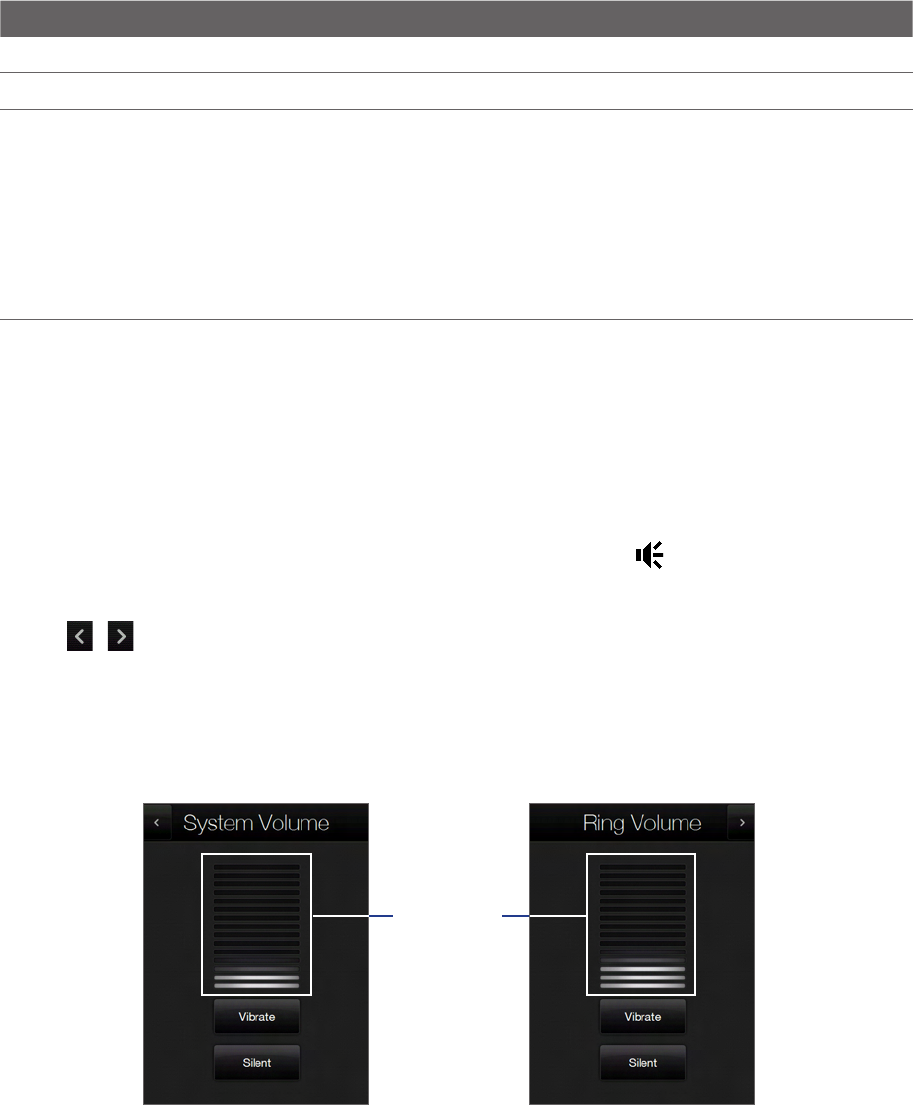
Getting Started 25
1.10 LED Alerts
The buttons below the touch screen and the exterior edge of the Navigation Control which is an LED ring will
light up in the following situations:
Controls Light Behavior
SEND button Light flashes when there is an incoming call.
END button Light stays solid when there is an incoming call.
Navigation Control The LED ring shows a “breathing” white light when the battery is being charged.
The LED ring shows a solid white light when the battery is fully charged.
The LED ring flashes a white light once when the battery level is low and reaches down to
about 10%.
The top and bottom parts of the LED ring flashes a white light twice when there is a new
e-mail, voice mail, or meeting reminder.
A white light goes around the LED ring counterclockwise twice starting from the top when
there is a missed call or new SMS message.
•
•
•
•
•
The LED ring, HOME, BACK, SEND, and END buttons will flash a white light once when one of the buttons or
Navigation Control is pressed.
1.11 Adjusting the Volume
Adjusting the system volume changes the volume level of sound notifications and audio/video playback,
whereas adjusting the ring volume affects only the volume of the phone ring. The system volume and ring
volume can be separately adjusted.
1. Touch the icon area in the title bar and then touch the Speaker icon ( ) on the System Status
screen.
2. To switch between the Ring Volume and System Volume screens, touch the Back and Next icons
( / ) on top of the screen.
3. On either screens, you can do the following:
To increase or decrease the volume level, drag your finger up or down the volume bars. You can also
press the VOLUME UP/DOWN buttons on the left panel of your device.
Touch Vibrate to enable or disable Vibrate mode.
Touch Silent to mute both the system and ring volume.
Volume bars
4. The System Volume or Ring Volume screen automatically closes. You can also manually close the screen
by touching the screen.
Note On certain screens that do not show the volume status icon on the title bar, you need to use the VOLUME
UP/DOWN buttons on the left panel of your device to adjust the volume. Also use these buttons to adjust the
conversation phone volume during an ongoing call.
•
•
•
26 Getting Started
1.12 Using your Device as a USB Drive
To easily carry media and other files with you, you can use the internal storage of your device as a USB flash
drive. Touch Start > Settings > Connections tab > USB to PC and then select Disk Drive mode. This allows
you to copy files from your computer to the device and vice versa faster.
When Disk Drive mode is used:
You will not be able to use your device to access files from the internal storage while it is connected to
your PC.
Your PC will only connect to the device’s internal storage. When you access your device from the PC, you
will only see the contents of the device’s internal storage.
Remember to change back to ActiveSync mode when you need to synchronize data between your device
and your PC.
•
•

Chapter 2
Using Phone Features
2.1 Using the Phone
2.2 Voice Call
2.3 Smart Dial
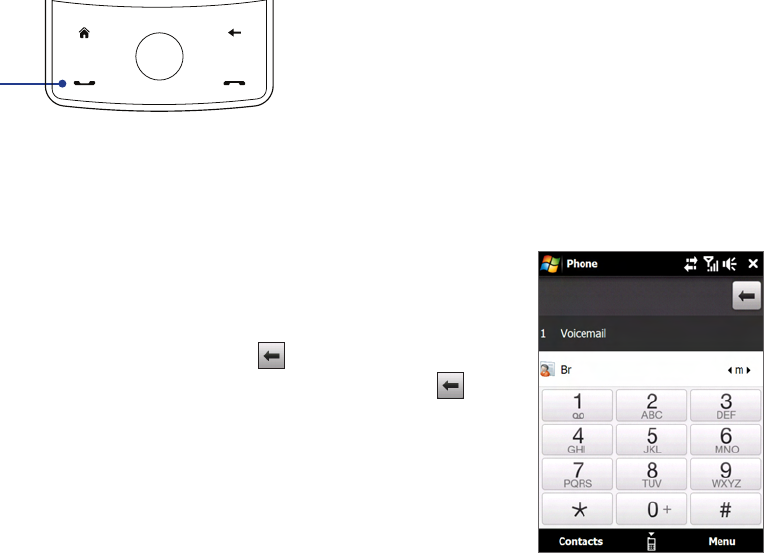
28 Using Phone Features
2.1 Using the Phone
Like a standard mobile phone, you can use your device to make, receive, and keep track of calls and send
messages.
The Phone screen
To open the Phone screen, do one of the following:
On the Home screen, tap Phone.
Press the TALK/SEND button.TALK/SEND button.
TALK/SEND button
2.2 Voice Call
Make a call
To make a call from the Phone screen
1. On the Home screen, tap Phone.
2. Tap the keys on the keypad to enter the phone number.
Note If you tapped a wrong number, tap to erase each subsequent
digit of a number. To erase the entire number, tap and hold .
3. Press the TALK/SEND button to place the call.TALK/SEND button to place the call.
Tip When in a call, use the VOLUME UP/DOWN buttons on the side of the device to adjust the phone volume.
Note After tapping 6 keys and the number you are dialing is not in your contacts, a Save to Contacts? button will
appear above the keypad. Tap it to save the number to your Contacts.
To make a call from Contacts
On the Home screen, tap Start > Contacts to open the Contacts screen.
Do one of the following:
Select the contact to call and then press TALK/SEND.
Note If the contact has more than one number stored, press Navigation right/left to select the number you
want to call before pressing TALK/SEND.
Tap the contact to open the contact details and then tap the phone number you want to call.
Tap and hold the contact you want to call and then from the menu, select Call Work, Call Home, or Call
Mobile.
To make a call from the TouchFLO 3D Home screen
Refer to Chapter 3 to learn how to make a call from the TouchFLO 3D Home screen.
To make an emergency call
Enter the international emergency number for your locale, and press the TALK/SEND button on your device.
•
•
•
•
•
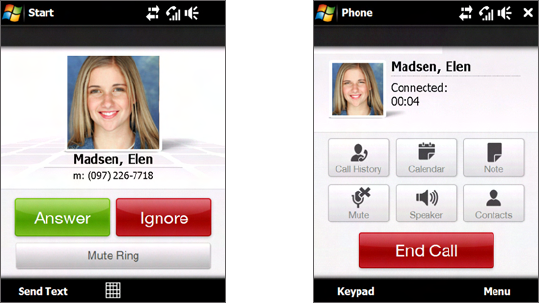
Using Phone Features 29
To make an international call
1. Tap and hold the number 0 key on the Phone screen until the plus (+) sign appears. The plus (+) sign
replaces the international prefix of the country that you are calling.
2. Enter the full phone number you want to dial, and press the TALK/SEND button on your device. The
full phone number includes the country code, area code (without the leading zero, if any), and phone
number.
To call voice mail
Number 1 is generally reserved for your voice mail. Tap and hold this button on the Phone screen keypad to
call voice mail and retrieve your voice mail messages.
Answer a call
When you receive a phone call, a message will appear, giving you the option to either answer or ignore the
incoming call. The TALK/SEND button will also flash when you receive a call.
To answer or reject an incoming call
To answer the call, tap Answer, or press the TALK/SEND button.
To reject the call, tap Ignore, or press the END button.
To mute the ringing sound without rejecting the call, tap Mute Ring.
Tip You can also place your phone face down to mute the ring without rejecting the call.
To reject a call and send a text message
When you reject a call, you can choose to automatically send a text message to the mobile phone of the caller.
1. On the Phone screen, tap Menu > Options > Advanced tab.
2. Select the Reject call with text message check box.
3. Change the default text message if needed, then tap OK.
When Reject call with text message is enabled, tap Send Text to reject the call and send the text message to
the caller.
To put a call on hold
Your device notifies you when you have another incoming call, and gives you the option of rejecting or
accepting the call. If you are already on a call and accept the new call, you can choose to switch between the
two callers, or set up a conference call between all three parties.
1. Tap Answer to take the second call, and put the first one on hold.
2. To end the second call and return to the first call, tap End Call or press END on your device.
To switch between two calls
Press the TALK/SEND button.
•
•
•

30 Using Phone Features
To turn on and off the Speakerphone
During a call, tap to toggle between turning on or off the speakerphone. The speakerphone icon
appears in the title bar when the speakerphone is on.
Tip You can also press and hold TALK/SEND to toggle between turning on or off the speakerphone.
Warning! To avoid damage to your hearing, do not hold your device against your ear when the Speakerphone is
turned on.
To mute the microphone during a call
Tap to toggle between turning on or off the microphone. When the microphone is turned off, the mute
icon appears on the screen.
To open Notes while in a call
Tap or pull out the stylus.
To vibrate the device when the call is established
You can set the device to vibrate once to alert you that the call has been established with the other party.
1. On the Phone screen, tap Menu > Options >Advanced tab.
2. Select the Vibrate device when connection is established check box and then tap OK.
End a call
When a call is in progress, tap End Call or press the END button to hang up.
To add a new phone number to Contacts after a call
If the phone number of the person who called is not in Contacts, you can choose to save the number after you
hang up.
1. On the Phone screen, tap Menu > Options > Advanced tab.
2. Select the Add new phone number to Contacts at end of call check box, then tap OK.
When you enable this option, a pop-up message appears after you end the phone call and lets you add the
phone number to Contacts.
To check a missed call
You will see the icon in the title bar when you missed a call. To check who the caller was, do one of the
following:
Tap the title bar, then tap and then tap View.
On the Phone screen, tap Menu > Call History and then tap .
Call History
Use Call History to check for missed calls, dialed numbers, and calls received. To open the Call History screen,
tap Menu > Call History on the Phone screen.
Speed Dial
Use Speed Dial to call frequently-used numbers with a single tap. For example, if you assign a contact to
the location 2 in Speed Dial, you can tap and hold the number 2 key on the Phone screen keypad to dial the
contact’s number.
To create a Speed Dial entry
1. On the Phone screen, tap Menu > Speed Dial.
2. Tap Menu > New.
3. Tap a contact, then select the phone number of the contact that you want assigned to the speed dial
key.
4. In Location, select an available key to use as the speed dial key.
•
•
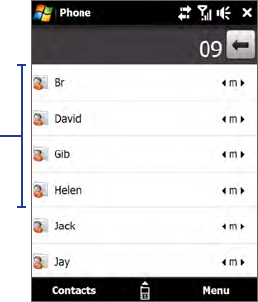
Using Phone Features 31
5. Tap OK.
Note When you assign a new phone number in an occupied speed dial key, the new phone number will replace the
existing one.
Tip To delete a Speed Dial entry, in the Speed Dial list, tap and hold the desired entry, then tap Delete.
Turn the phone function on and off
In many countries, you are required by law to turn off the phone while on board an aircraft.
To enable or disable the phone function
1. Tap Start > Settings > Connections tab > Comm Manager.
2. On the Comm Manager screen, tap the Phone button to enable or disable the phone function.
When enabled, the ON indicator is activated.
To enable or disable Airplane Mode
Another way to turn off the phone function is to switch your device to Airplane Mode.
When you enable Airplane Mode, all wireless radios on your device are turned off, including the phone
function and Bluetooth.
When you disable Airplane Mode, the phone function is turned back on and the previous state of Bluetooth is
restored.
1. Tap Start > Settings > Connections tab > Comm Manager.
2. On the Comm Manager screen, tap the Airplane Mode button to enable or disable Airplane Mode.
When enabled, the ON indicator is activated.
2.3 Smart Dial
Smart Dial panel
Smart Dial makes it easy for you to dial a phone number.
When you start entering a phone number or contact
name, Smart Dial automatically searches and sorts the
contact entries in Contacts, and the phone numbers in
Call History (including incoming, outgoing, and missed
calls). You can then select the desired number or contact
from the filtered list to dial.
To find a contact name or number
You can just enter the first letter of the name or number of a contact. Smart Dial will search for contact
phone numbers and the first character of a contact name as well as from the character that appears after
a space, dash, or underscore in a contact name. For example, if you tap number “2” on the phone keypad,
which is associated with [a, b, and c] on the Phone keypad, contact names such as the following will be
considered matches: “Ben Miller”, “George Adams”, “John-Carter”, “Carter, Ellen”, “Dixon, Allan”, “Thomas_Clark”,
“JaneCampbell”.
If the matching list is long and you want to narrow down the search further, enter another letter. Using the
same example above, if you continue to tap “3” which is associated with [d, e, f], the matching list will be
narrowed down to the following names: “Ben Miller”, “George Adams”, “Carter, Ellen”, “Dixon, Allan”.

32 Using Phone Features
Make a call or send a text message using Smart Dial
1. On the Home screen, tap Phone.
2. Begin entering the first few numbers or characters. When you start entering a number or letter, the
Smart Dial panel will display matches found.
Tip Tap to close the phone keypad to see if there are more matching contacts.
3. In the Smart Dial panel, flick and slide your finger on the touch screen or press Navigation up/down to
browse the list or select a contact.
4. You can do one of the following:
Tap the contact to call the selected contact.
To send a text message to the selected contact, tap Menu > Send Text Message.
To call a different phone number associated with the selected contact, select the contact and then
press Navigation left/right to select the number to call.
•
•
•

Chapter 3
TouchFLO™ 3D
3.1 About TouchFLO™ 3D
3.2 Using the TouchFLO 3D Home Screen
3.3 Finger Gestures
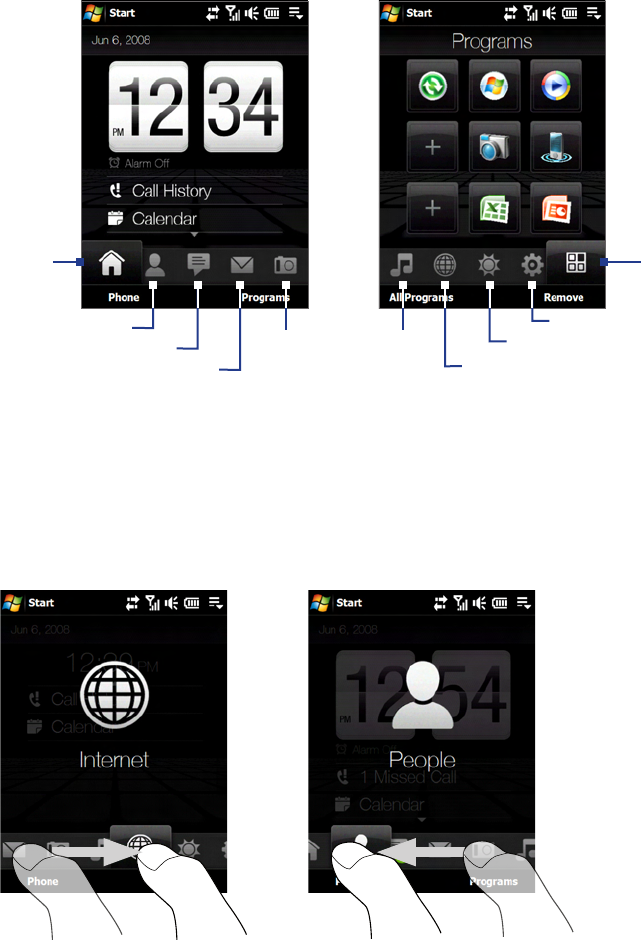
34 TouchFLO™ 3D
3.1 About TouchFLO™ 3D
TouchFLO™ 3D gives you touch control over your Windows Mobile-powered device. TouchFLO 3D provides
the following features:
A Home screen that allows finger-touch access to the most widely-used functions, such as People,
Messages, Mail, Music, Internet, and more.
Allows you to use finger gestures to navigate screens.
3.2 Using the TouchFLO 3D Home Screen
The TouchFLO 3D Home screen have the following tabs:
Home
People
Messages
Mail
Photos and
Videos
Music
Internet
Settings
Programs
Weather
To switch between the tabs of the Home screen
Do one of the following:
Touch or tap the desired tab on the Home screen.
Press Navigation right or left to move to the next or previous tab.
Press and hold your finger on the active tab, then slide your finger right or left over the tabs.
Release when you have selected the desired tab.
Note Apply some pressure when pressing and holding on the active tab to be able to slide over the tabs.
•
•
•
•
•
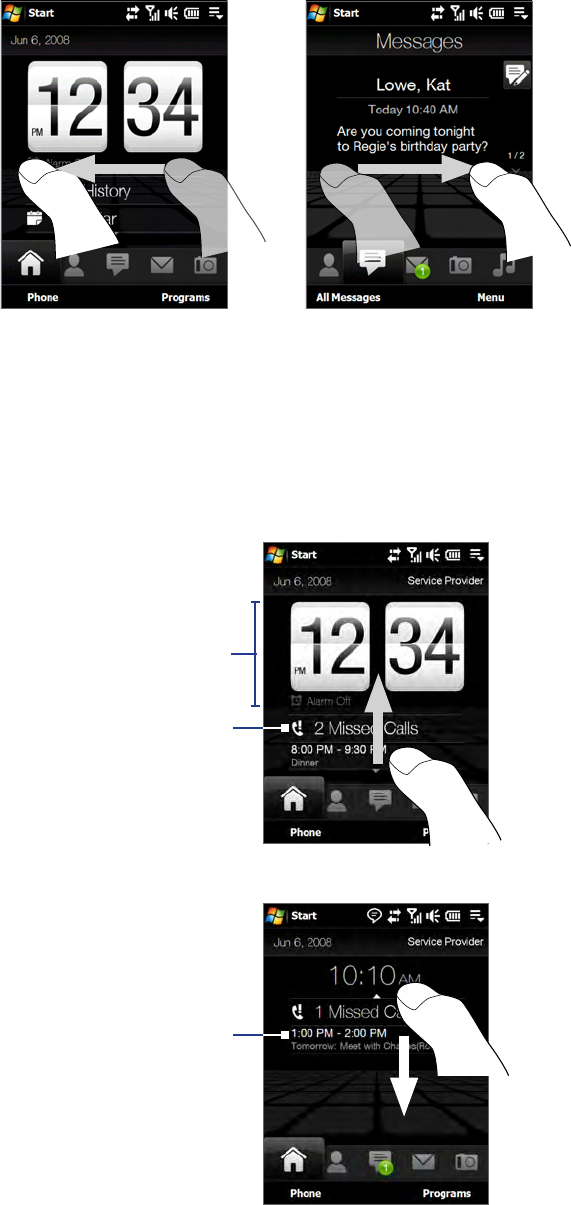
TouchFLO™ 3D 35
Swipe left across the screen to move to the next tab, and swipe right across the screen to move to the
previous tab.
Home
The Home tab displays the current date, a flip-style clock, and an Alarm icon that indicates whether the alarm
is on or off. Missed calls and your upcoming calendar appointments are also shown on the Home tab.
To select an item on the Home tab
Touch the item; or
Press Navigation up or down first to navigate to the item you want to select and then press ENTER.
Touch the date or the flip clock
to open the Clock & Alarms
screen where you can set the
date, time, and alarm.
(See Chapter 13 for details.)
Swipe downward on the screen
to change back to the flip clock.
One all-day appointment and
up to two timed appointments
can be displayed. Touch this
area to create, edit or view an
appointment.
(See “Calendar” in Chapter 12
for details.)
Home tab with smaller digital clock
Swipe upward on the screen to
display the smaller digital clock
and view more appointments.
Touch this area to view details
about missed calls in the Call
History.
(See Chapter 2 for details.)
Home tab with flip clock
•
•
•
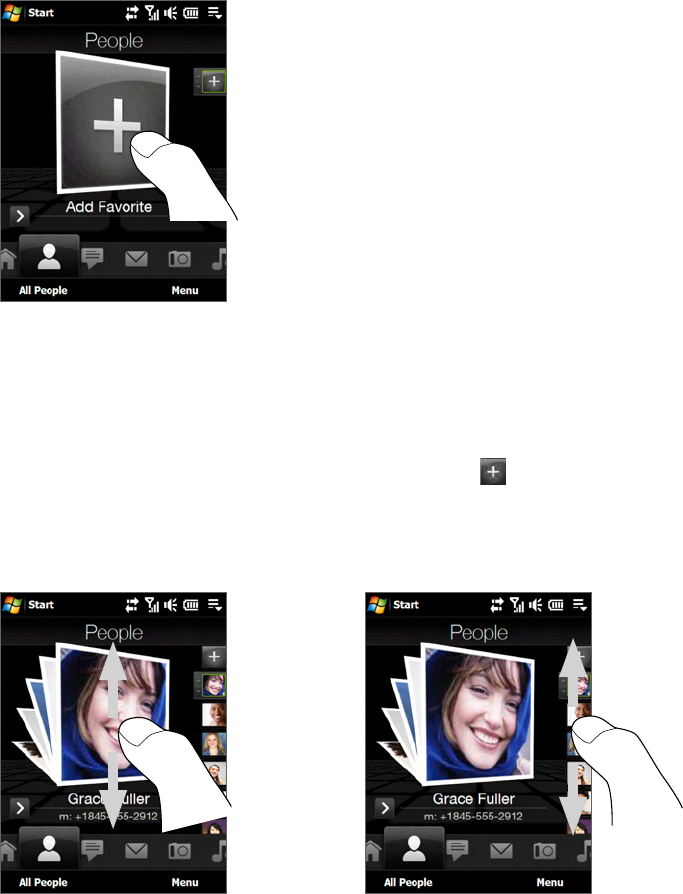
36 TouchFLO™ 3D
People
On the People tab, you can add favorite contacts who you most frequently communicate with. This allows
you to quickly make calls, send text messages, and send e-mails to your favorite contacts.
Tip You can add up to 15 favorite contacts on the People tab.
To add favorite contacts
You should already have created or synchronized contacts on your device before you can add them to the
People tab.
1. On the Home screen, slide your finger to the People tab.
2. Touch the small or big Plus icon, or touch Add Favorite.
3. On the Select a Contact screen, touch the name of the desired contact.
Tip To create a new contact, touch Menu > New Contact. See “Contacts” in Chapter 12 for details.
4. Select a phone number or e-mail address to associate to the favorite contact.
Note If there is no picture associated with the contact, the next screen prompts you to assign a picture to the
contact.
5. To add another favorite contact, touch the small Plus icon ( ) at the right side of the screen and
repeat steps 3 and 4.
To choose from your favorite contacts
Do any of the following:
To flip through the contact pictures
one at a time, swipe your finger up
or down the screen. You can also
press Navigation up or down to flip
through the contact pictures.
On the picture strip at the right side of the People
screen:
Touch the picture of the desired favorite contact; or
Press and hold on the currently selected contact
picture to display a slide-out bar, and then slide up
or down the picture strip. Release your finger when
the desired favorite contact is selected.
•
•
•
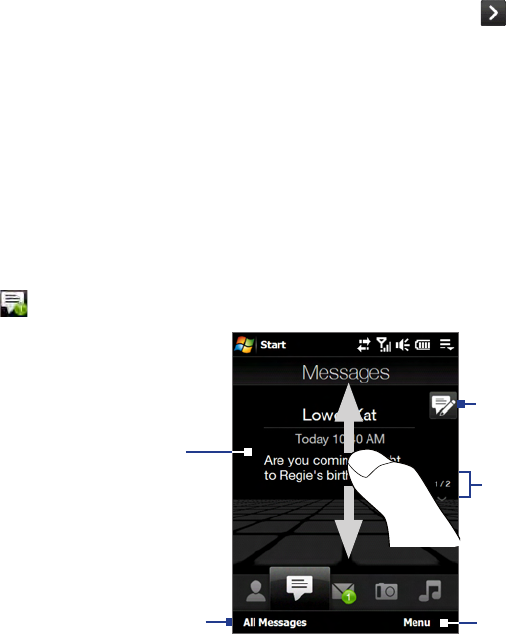
TouchFLO™ 3D 37
After selecting a favorite contact, touch the right arrow icon ( ), the phone number or e-mail address
shown below the contact picture to place a call, send a text message, or send an e-mail to the contact.
Touch the picture of the contact on the center screen to access his or her contact card. On the contact
card, you will see the last outgoing or incoming call as well as contact details such as phone numbers,
e-mail address, and more.
Tips • On the People tab, touch All People to access all contacts that are stored on your device.
• To remove the current favorite contact, touch Menu > Remove Favorite.
Messages
On the Messages tab, you can read text messages as they arrive and create a new text message. When there
are new incoming text messages, the icon on the Messages tab will show the number of new messages. For
example, indicates that there is a new message received.
To view the entire message
thread from the sender and
reply, touch the message on
the screen.
Touch All Messages to access
all text messages in your inbox
and other folders.
Touch this icon to create a new text
message.
To flip through received text messages,
swipe your finger upward/downward,
touch the Up/Down arrow on the
screen, or press Navigation up/down.
Touch Menu to remove the current
message and access more options.
For more information about working with text messages, see “Text Messages” in Chapter 6.
Mail
The Mail tab is where you send and receive e-mail messages. Including Outlook E-mail, you can add up to four
POP3/IMAP4 and Web-based e-mail accounts in this tab.
To add an e-mail account
1. On the Home screen, slide your finger to the Mail tab.
2. If this is your first time to add an e-mail account, touch New Account on the bottom-right side of the
screen.
3. Set up your e-mail account using the E-mail Setup wizard.
4. To add another e-mail account, touch Menu > Accounts > New Account and use the E-mail Setup
wizard to set up your account.
For detailed instructions on setting up e-mail accounts using the E-mail Setup wizard, see Chapter 6.
To check e-mail
When there are new e-mails, the icon on the Mail tab and the respective icons of the e-mail accounts will
show the number of newly received messages.
•
•
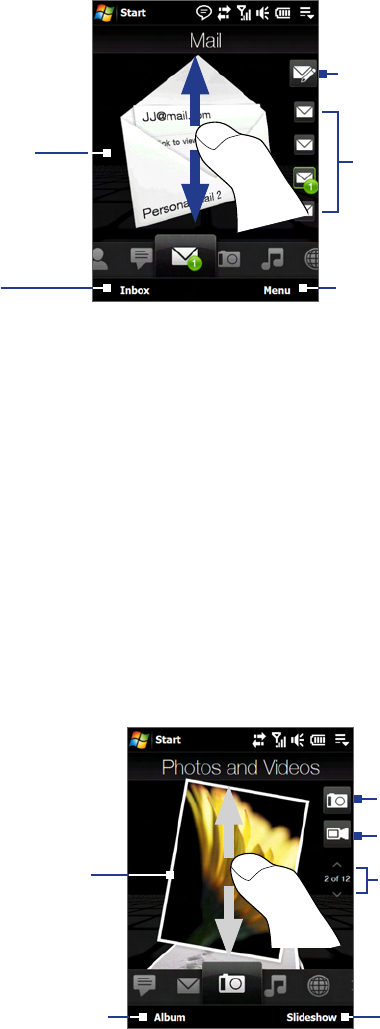
38 TouchFLO™ 3D
To browse through received
e-mails, swipe up or down on
the envelope image or press
Navigation up/down.
Touch the e-mail on the screen
to open and read the message.
•
•
Touch Inbox to access all
e-mail messages of the
currently selected account.
After selecting an e-mail account,
touch this icon to create and send a
new e-mail message.
These are your e-mail accounts.
Touch an icon to select an e-mail
account and view the new e-mails
received in that account.
Touch Menu to access more options.
For more information about working with e-mails, see Chapter 6 and 7.
Photos and Videos
The Photos and Videos tab lets you visually flip through your photos and video clips and view them in full
screen. From this tab, you can also activate the Camera so you can take pictures and record video clips.
The Photos and Videos tab displays pictures and video files from the current favorite album. By default, the
Camera Shots album which stores the pictures and videos that you captured using the device camera is set as
the favorite. You can change to another favorite album, if preferred.
To set an album as a Favorite
1. On the Photos and Videos tab, touch Album to open the Album program.
2. Touch Albums and then select one of the listed favorite albums.
3. Tap Menu > Set as Favorite. and then tap OK on the confirmation screen.
To view photos and videos
Touch the photo or video on
the screen to view or play it
in full screen.
Touch here to open the Album
program. (See “Viewing Photos
and Videos Using Album” in
Chapter 11 for details.)
Touch here to take a photo.
Touch Slideshow to view the
photos as a slideshow. If a video
is selected, touch Play.
To flip through photos and videos,
swipe upward/downward, touch the
Up/Down arrow, or press Navigation
up/down.
Touch here to shoot video.
Tips • For more information about viewing in full screen, see “View an image” and “Play back video” in Chapter 11. The
file formats that can be viewed on the Photos and Videos tab are the same as the Album program.
• To transfer media files from a computer and view them on the Photos and Videos tab, copy or synchronize them
to a folder under \My Device (the device memory) or \Internal Storage (the built-in storage).
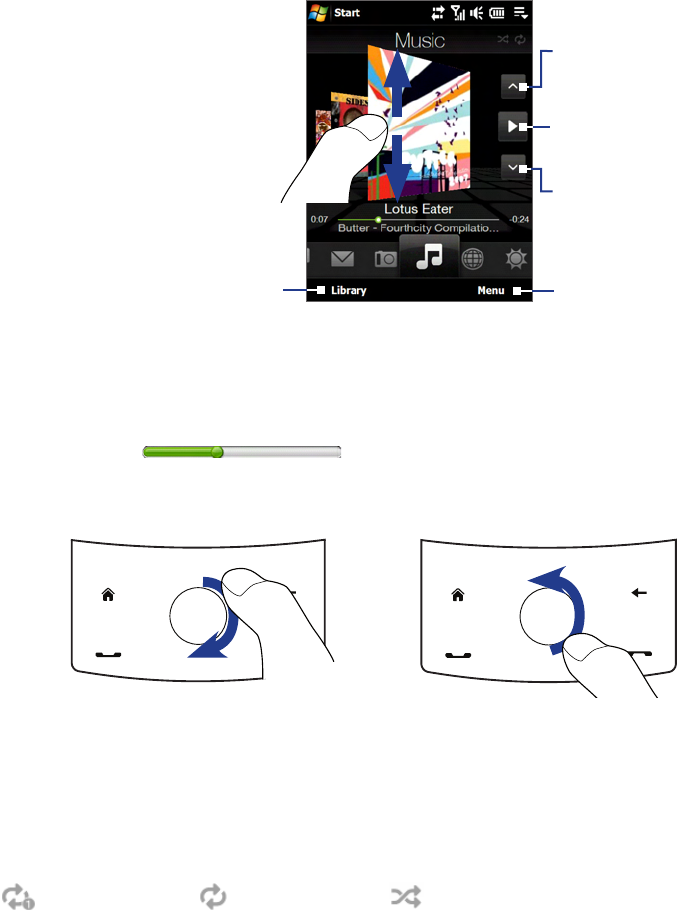
TouchFLO™ 3D 39
Music
The Music tab allows you to visually browse through albums and music tracks and play music. The albums
and music tracks that you see on the Music tab are from the Now Playing list of the Library.
Note Your device searches for all music files that have the following audio formats: MP3 (.mp3), WMA (.wma), AAC/AAC+
(.aac), and MPEG-4 (.m4a). It searches for music from the following locations:
Device: \My Music (including all subfolders)
\My Documents (including all subfolders)
Storage: \Internal Storage (including all subfolders)
To play music
On the Music tab, flip through albums and all the music in each album, then touch the Play icon on the
middle-right side of the screen to start playback.
Touch here to go to the previous
album or the previous music in
the current album.
Swipe upward/downward on the
screen or press Navigation up/
down to flip through albums and
the music or songs in an album.
Touch here to play or pause. You
can also press the ENTER button to
play or pause.
Touch here to go to the next album or
the next music in the current album.
Touch Menu to set music playback to
Repeat, turn Shuffle on or off, and more.
Touch here to access the Library.
To advance forward or backward in the music
Do one of the following:
Touch and hold on the thin bar below the album art to display the progress bar:
Drag your finger right or left on the progress bar to move forward or backward in the current music.
Slide your finger around the Navigation Control as follows:
To move backward in the music,
slide your finger counterclockwise.
Slide your finger clockwise to
advance forward in the music.
To set repeat and shuffle modes
Touch Menu > Repeat and choose whether to repeat once, repeat all, or do not repeat. To toggle shuffle
mode on and off, touch Menu > Shuffle and then select Shuffle On or Shuffle Off.
The icons on the upper-right side of the Music tab show whether repeat and shuffle modes are enabled.
Repeat [One] Repeat [All] Shuffle [On]
•
•
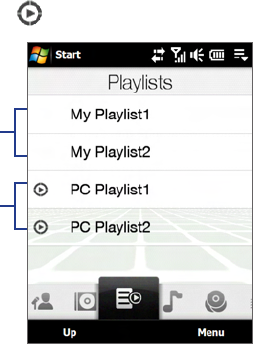
40 TouchFLO™ 3D
To browse and play music in the Library
The Library organizes music into categories, such as Now Playing, Artists, Albums, Genres, All Songs, and
more. When you add more albums or music tracks to your device, go to the Library to locate and play the new
albums or music tracks.
1. On the Music tab, touch Library to open the Library screen.
2. The tabs at the bottom of the Library screen correspond to the different categories. To browse music
under a certain category, slide to the tab that corresponds to the desired category.
3. Tap a music track to play it.
Note When you select a category in the Library such as Artists and play its music, the Now Playing list will be replaced
with the music tracks from that category.
To use playlists
You can group your favorite music into a playlist and then play back the playlist.
To create a new playlist:
1. Select the desired music on the Music tab or the Library.
2. Touch Menu > Add to Playlist.
3. Touch <New Playlist>, enter a Playlist name and then touch OK.
To add more music files to a playlist:
1. On the Playlists tab, touch a playlist to open it.
2. Touch Menu > Edit.
3. Touch Menu > Add.
4. Select the check boxes of the music you want to add to the playlist, or touch Menu > Select All to
choose all the music.
5. Touch OK three times and then touch Up to return to the Playlists tab.
To play back a playlist:
1. On the Playlists tab, touch a playlist to open it.
2. Touch the first song in the playlist. The Music tab starts playing the first song. After each song, the
next one in the playlist will be played.
Note Playlists are not automatically updated when music files have been deleted from the device memory or internal
storage.
There are two types of playlists that can be shown on the Playlists tab:
Custom playlists. Playlists that are created on the Music tab.
Windows Media® Player playlists. Playlists that are in Windows Media® Player Mobile’s Library (which
is synchronized with Windows Media® Player on your computer). They are indicated by the Windows
Media® Player icon ( ). These playlists cannot be edited.
Custom playlists
Windows Media®
Player playlists
Note If a Windows Media® Player playlist contains a combination of music, video and image files, only music files in the
playlist will be synchronized to your device and other media types will be filtered out.
•
•
•
•
•

TouchFLO™ 3D 41
Internet
On the Internet tab, you can open Opera Mobile™ to browse the Web and add Web favorites for one-touch
access to your favorite Web sites.
Touch here to browse the
Web using Opera Mobile.
Touch All Bookmarks to open
Opera Mobile and add, view or
delete Web favorites.
Swipe upward or press Navigation
down to scroll down the screen
and access more Web favorites.
For more information about using Opera Mobile, see Chapter 8.
Weather
The Weather tab shows you the current weather as well as weather information for the next five days of the
week.
To add a city
The Weather tab can display weather information of your local city and other added cities. Follow the steps
below to add a city on this tab.
Tip You can add up to 10 cities in the Weather tab.
1. On the Weather tab, touch Menu > Add Location.
2. The Select Country screen then appears. Flick your finger on the screen repeatedly in light, quick
strokes to continuously scroll down the list of countries. You can also slowly scroll through the country
list by dragging your finger upward on the screen. Touch the desired country to select it.
3. The Select City screen then appears. Flick your finger on the screen repeatedly in light, quick strokes
to continuously scroll down the list of cities. You can also slowly scroll through the city list by dragging
your finger upward on the screen. Touch the desired city to select it.
To view weather information
Your device automatically connects to the Internet via the data connection or Wi-Fi to download and display
weather information. The current temperature, temperature range, type of weather (sunny, cloudy, showers,
or others), and the time of day (daytime or nighttime) are shown on the Weather tab. To see the weather
information for the next five days of the week, touch the screen or touch 5-day at the bottom-left side of the
screen.
Touch the screen or touch 5-day
at the bottom to see the weather
information for the next five days
of the week.
Touch Menu to add or delete a
city, change the temperature to
Celsius or Fahrenheit, and more.
Shows the last weather update.
Touch this item to download the
latest weather information.
To switch between cities, swipe your
finger upward/downward, touch the
Up/Down arrow on the screen, or
press Navigation up/down.
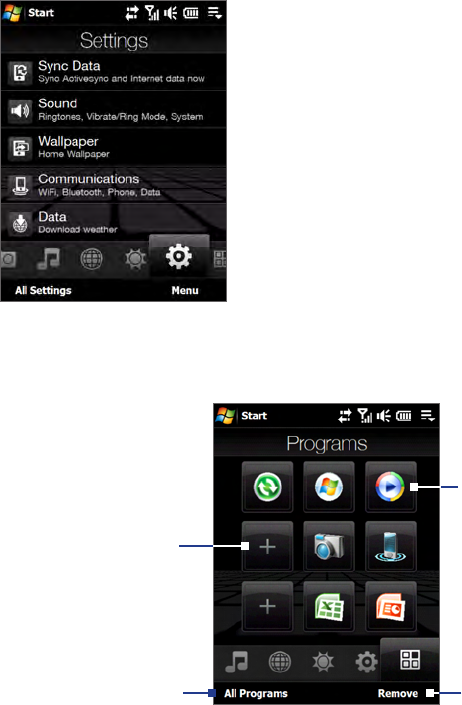
42 TouchFLO™ 3D
To choose download options
1. On the Weather tab, touch Menu > Settings.
Tip You can also slide to the Settings tab and then touch Data.
2. You can choose from the following options:
Download weather automatically. When this option is selected, weather information is
automatically downloaded from the AccuWeather Web site whenever you select the Weather tab,
if the data has not been updated within the last three hours. Weather data is also downloaded every
time an ActiveSync connection is established (through over-the-air or USB connections). Clear this
option if you prefer to manually download weather information.
Download weather when roaming. Select this option only if you want to allow automatic
download of weather data when roaming. This may incur additional costs.
Settings
The Settings tab allows you to synchronize information with your computer or the Exchange Server, change
sound settings such as the ring tone, and choose a different wallpaper for the Home tab. You can also easily
turn on and off the communications features of your device such as Wi-Fi, Bluetooth, and more.
Programs
The Programs tab allows you to add your favorite programs for one-touch access.
Touch a program icon to
open the corresponding
program.
Touch Remove to choose
which program to remove
from the Programs tab.
Touch an empty slot to
add a favorite program.
Touch All Programs to
access all the programs
of your device.
When you have filled up the screen with programs, scroll down the Programs tab to access more empty slots
and add more programs. To scroll down, press and hold on the screen and then drag your finger upward. You
can add up to 18 favorite programs.
To scroll back up, press and hold on the screen and then drag your finger downward.
Note To replace a slot with another program, you must delete the occupying program shortcut first and then add your
desired program.
•
•
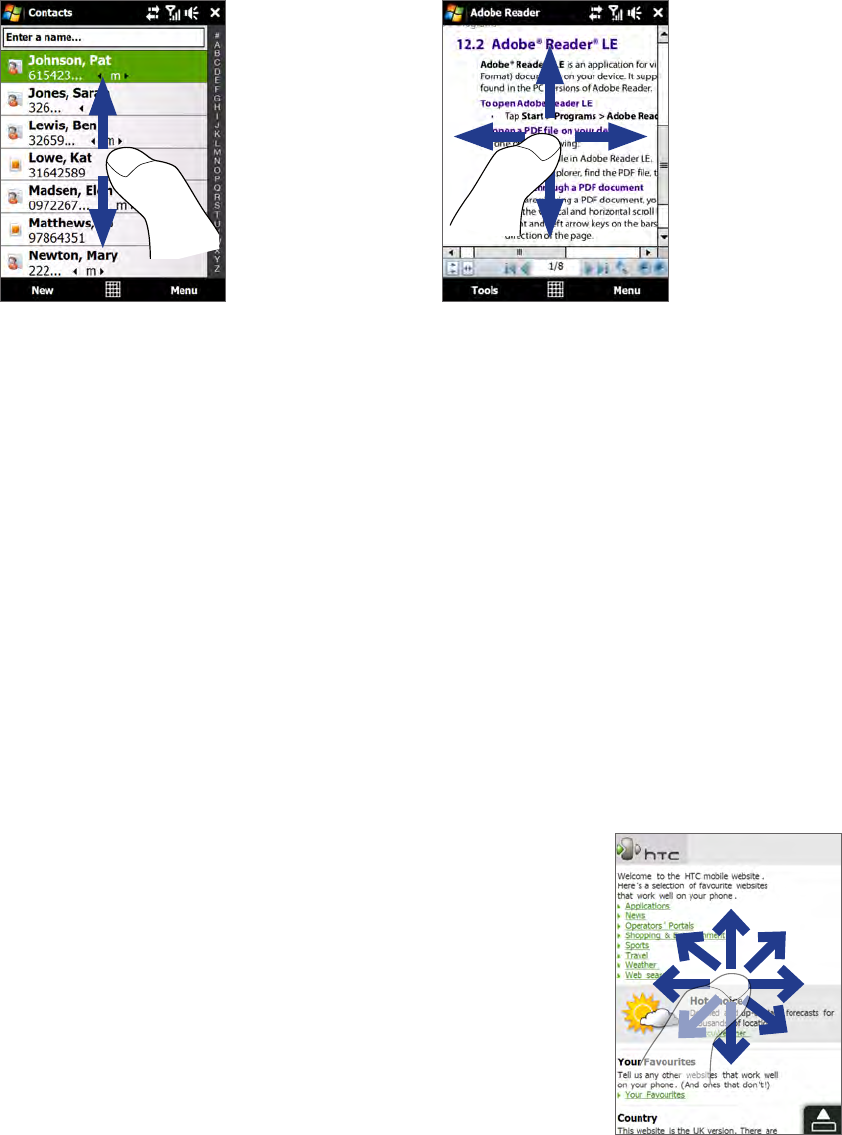
TouchFLO™ 3D 43
3.3 Finger Gestures
You can use finger gestures to scroll, zoom and pan on the touch screen.
Finger scrolling
Finger scrolling can be used to scroll up and down Web pages, documents, and lists such as the contacts list,
file list, message list, calendar appointments list, and more.
When finger scrolling,
swipe or flick your finger
on the touch screen.
To scroll up and down
To scroll down, swipe your finger upward on the touch screen. To scroll up, swipe your finger downward
on the touch screen.
To auto-scroll, flick your finger upward or downward on the touch screen. Touch the screen to stop
scrolling.
To scroll left and right
To scroll towards the right, swipe your finger to the left.
To scroll towards the left, swipe your finger to the right.
To auto-scroll, flick your finger left or right. Touch the screen to stop scrolling.
Finger zooming
The type of finger gesture to use when zooming varies in different programs.
To zoom in on a Web page in Opera Mobile, tap your finger twice on the screen. See “Using Opera
Mobile” in Chapter 8 for details.
To zoom in on a photo in Album, make a full-circle swipe on the touch screen. See “Viewing Photos and
Videos Using Album” in Chapter 11 for details.
Finger panning
You can use finger panning to move to and view other parts of a zoomed
photo, Web page, document, or an e-mail. To pan, touch and hold on the
touch screen and then drag your finger in any direction.
Tip To enable or mute finger scrolling and panning sound, touch Start > Settings
> System tab > TouchFLO, and then select or clear the Enable sound when
finger scrolling and panning check box.
•
•
•
•
•
•
44 TouchFLO™ 3D

Chapter 4
Entering Text
4.1 Selecting an Input Method
4.2 Using the Full QWERTY
4.3 Using the Compact QWERTY
4.4 Using the Phone Keypad
4.5 Using Multitap and T9 Modes
4.6 Using Numeric and Symbol Mode
4.7 Using Block Recognizer
4.8 Using Letter Recognizer
4.9 Using Transcriber
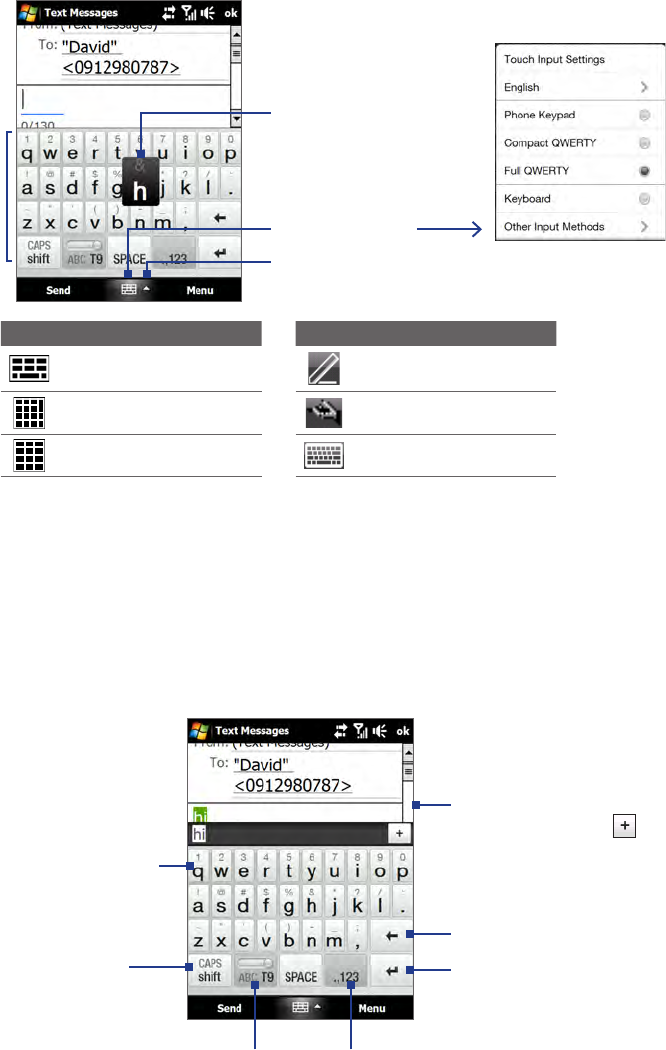
46 Entering Text
4.1 Selecting an Input Method
When you start a program or select a field that requires text or numbers, the Input Panel icon becomes
available on the menu bar.
Tap the Input Selector arrow (that appears next to the Input Panel icon) to open a menu where you
can select a text input method and customize input options. After selecting a text input method, the
corresponding Input Panel is displayed, which you can use to enter text.
Tip Select Other Input Methods to display more input methods.
To show or hide the Input Panel, tap the Input Panel icon.
Input Panel
(Full QWERTY)
Input Selector arrow
Input Panel icon
Text input methods
Key when pressed
Icon Input method Icon Input method
Full QWERTY Letter Recognizer or
Block Recognizer
Compact QWERTY Transcriber
Phone Keypad Keyboard
Notes • Some text input methods may not be available in certain language versions of the device.
• When in landscape mode, the Compact QWERTY and Phone Keypad are not available.
4.2 Using the Full QWERTY
The Full QWERTY is a full on-screen QWERTY keyboard layout similar to a desktop PC keyboard.
Tip You can also use the Windows Mobile on-screen keyboard which also has a QWERTY keyboard layout by selecting
Keyboard (or Other Input Methods > Keyboard) on the Text input method menu.
• Tap to enter letters or symbols.
• Tap and hold to enter a punctuation
mark, symbol, or number that
appears on top of a key
• Tap to enter an uppercase letter.
• Tap twice to turn on Caps Lock.
Tap to toggle between
using Normal or T9 mode.
Tap to open a keyboard layout that lets you easily
enter numbers and symbols.
See “Using Numeric and Symbol mode” for details.
Tap to create a new line.
Tap to delete the previous character.
Displays the word candidate list
in T9 mode. Tap a word to insert
it into your text. Tap to add a
word to the T9 dictionary.
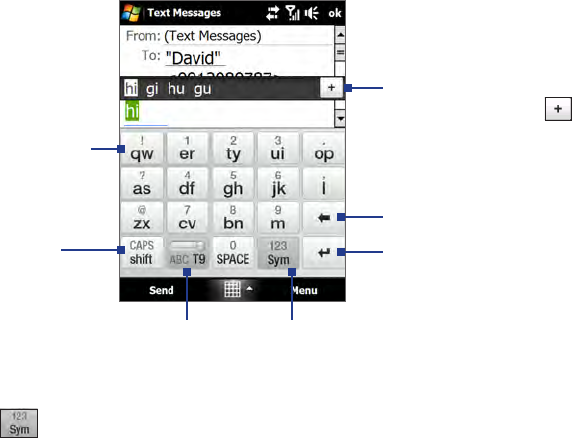
Entering Text 47
To enter text using the Full QWERTY
1. Start a program that accepts text input, such as Word Mobile.
2. Tap the Input Selector arrow, then tap Full QWERTY.
3. Start tapping keys on the keyboard as you would on a PC keyboard to enter your text. To learn how to
enter text using T9 mode, see “Using Multitap and T9 modes” in this chapter.
4.3 Using the Compact QWERTY
The Compact QWERTY is a type of on-screen keyboard which features 20 keys. With its large, touch-friendly
keys and enhanced features such as T9 predictive input, you can enter text faster and more accurately.
• Tap to enter letters or symbols.
• Tap and hold to enter a punctuation
mark, symbol, or number that
appears on top of a key
• Tap to enter an uppercase letter.
• Tap twice to turn on Caps Lock.
Tap to toggle between
using Multitap or T9 mode.
Tap to open a keyboard layout that lets you easily
enter numbers and symbols.
See “Using Numeric and Symbol mode” for details.
Tap to create a new line.
Tap to delete the previous character.
Displays the word candidate list
in T9 mode. Tap a word to insert
it into your text. Tap to add a
word to the T9 dictionary.
Tip You can tap and hold to immediately open the numeric keyboard.
To enter text using the Compact QWERTY
1. Start a program that accepts text input, such as Word Mobile.
2. Tap the Input Selector arrow, then tap Compact QWERTY.
3. Start tapping keys on the keyboard to enter your text. To learn how to enter text using Multitap or T9
mode, see “Using Multitap and T9 modes” in this chapter.
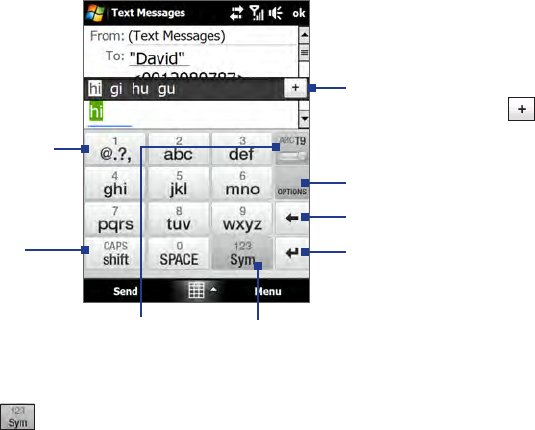
48 Entering Text
4.4 Using the Phone Keypad
The Phone Keypad is a 12-key on-screen keypad that has a layout similar to mobile phone keypads, plus
some additional keys. The Phone Keypad has large keys and enhanced input features such as T9 predictive
input, which makes it faster for you to enter text in your messages and documents.
Tap to open the input settings.
• Tap to enter letters or symbols.
• Tap and hold to enter a punctuation
mark, symbol, or number that
appears on top of a key
• Tap to enter an uppercase letter.
• Tap twice to turn on Caps Lock.
Tap to toggle between
using Multitap or T9 mode.
Tap to open a keyboard layout that lets you easily
enter numbers and symbols.
See “Using Numeric and Symbol mode” for details.
Tap to create a new line.
Tap to delete the previous character.
Displays the word candidate list
in T9 mode. Tap a word to insert
it into your text. Tap to add a
word to the T9 dictionary.
Tip You can tap and hold to immediately open the numeric keyboard.
To enter text using the Phone Keypad
1. Start a program that accepts text input, such as Word Mobile.
2. Tap the Input Selector arrow, then tap Phone Keypad.
3. Start tapping keys on the keyboard to enter your text. To learn how to enter text using Multitap or T9
mode, see “Using Multitap and T9 modes” in this chapter.
4.5 Using Multitap and T9 Modes
When using the on-screen keyboards, you can choose to enter text using Multitap or T9 mode.
Multitap mode
In Multitap mode (for Compact QWERTY and Phone Keypad), enter a character by tapping a key until the
desired character is displayed on the screen.
To enter the first letter that shows on a key, tap the key once. To enter the second letter, tap twice.
To enter a punctuation mark, symbol, or number that appears on top of a key, tap and hold the key.
T9 mode
T9 is a predictive text input mode which displays a word candidate list as you enter the first few characters so
you just select the word that you want.
To enter text using T9 mode
1. Start entering the first few letters of a word. As you enter each letter, predicted words will appear above
the keyboard.
2. Tap the desired word to immediately insert it to your text.
Note Navigate through the word candidate list if there are more words to choose from.
•
•
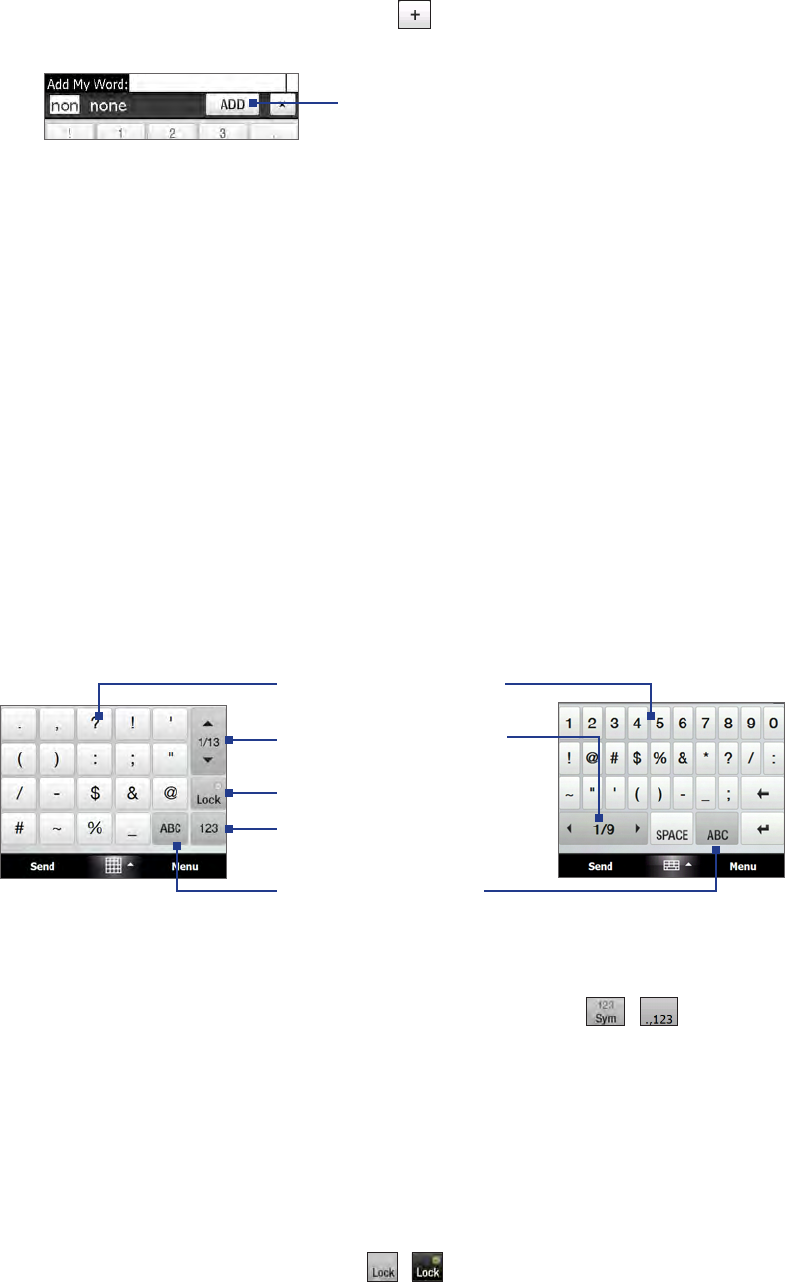
Entering Text 49
To add a word to the T9 dictionary
If the word that you have entered is not found in the dictionary, you can add it to the dictionary.
1. While in T9 mode, type a letter and then tap on right side of the word candidate list.
2. Type the word you want to add and then tap ADD.
Tap to not add the word.
To customize Touch Input settings
1. Tap the Input Selector arrow, then tap Touch Input Settings.
2. On the Touch Input Settings screen, select or clear the following options according to your preferences:
Spell Correction. Lets you correct typographical errors by selecting from a list of possible words
that reflect the characters of the keys you have tapped as well as characters of nearby keys.
Word Completion in T9 mode. Lets you select from a list of possible words based on the keys that
you have tapped and on the words available in the dictionary.
Word Completion in ABC mode. Lets you select from a list of possible combinations based on the
characters that appear on the keys that you tapped.
Auto-Substitution. Automatically inserts an apostrophe when you type common contracted
words (for example, “dont” automatically becomes “don’t”).
3. Tap Done.
4.6 Using Numeric and Symbol Mode
Switch to Numeric and Symbol mode to let you easily enter numbers and common symbols such as
parentheses, braces, currency signs, punctuation marks, special characters, and more. Numeric and Symbol
mode is available when using the Full QWERTY, Compact QWERTY, and Phone Keypad.
Tap a number or symbol to
insert it into your text.
Tap to go to the previous or
next page of symbols.
Tap to switch back to the
letter keyboard layout.
Tap to switch to the numeric
keyboard
See “To lock the keyboard in
Numeric and Symbol mode.”
Compact QWERTY
and Phone Keypad Full QWERTY
To switch to Numeric and Symbol mode
1. While using Full QWERTY, Compact QWERTY, or Phone Keypad, tap / .
2. Locate the number or symbol, then tap it to insert it into your text.
To lock the keyboard in Numeric and Symbol mode
You can lock the keyboard in Numeric and Symbol mode so you can continuously enter symbols and
numbers.
1. Tap the Input Selector arrow and then tap Other Input Methods > Options.
2. In the Input Method tab, select a Touch input method in the Input method list, then tap Options.
3. Clear the Turn on one-touch symbol entry check box.
Tip In Compact QWERTY and Phone Keypad, tap / to toggle between locking the keyboard in Numeric and
Symbol mode and switching back to the letter keyboard layout after tapping a symbol or number.
•
•
•
•

50 Entering Text
4.7 Using Block Recognizer
With Block Recognizer, you use a single stroke to write letters, numbers, symbols, and punctuation, which
are then converted into typed text.
To use Block Recognizer
1. From a program, tap the Input Selector arrow and then tap Other Input Methods > Block
Recognizer.
2. Write characters, numbers, and symbols in the designated writing area.
Enter letters by writing in the abc (left) area of the box.
Enter numbers by writing in the 123 (right) area of the box.
Enter symbols and punctuation by tapping the left or right area of the box (a gray dot appears),
then writing the desired character.
Tip For help with writing characters, tap the question mark near the writing area.
4.8 Using Letter Recognizer
With Letter Recognizer, you can write individual letters, numbers, and punctuation marks, which are then
converted into typed text.
To use Letter Recognizer
1. From a program, tap the Input Selector arrow and then tap Other Input Methods > Letter
Recognizer.
2. Write characters, numbers, and symbols in the designated writing area.
Enter uppercase letters by writing in the ABC (left) area of the box.
Enter lowercase letters by writing in the abc (middle) area of the box.
Enter numbers by writing in the 123 (right) area of the box.
Enter punctuation and symbols by writing the desired character in the 123 (right) area of the box.
Tip For help with writing characters, tap the question mark near the writing area.
4.9 Using Transcriber
Transcriber is a handwriting recognition program that enables you to write in cursive, print, or a combination
of both.
To write using Transcriber
1. Open a program that accepts user input, such as Word Mobile.
2. Tap the Input Selector arrow and then tap Other Input Methods > Transcriber. The Transcriber
introductory screen appears. Read the introduction and tap OK.
3. Position the cursor where you want text to appear.
4. Use the stylus to write anywhere on the screen. The handwriting will be converted to text shortly after
you lift the stylus from the screen.
To enter punctuation and symbols
Transcriber comes with an on-screen keyboard that provides an easy way to add punctuation or a special
symbol to existing text. To use this on-screen keyboard, tap on the Transcriber toolbar.
The keyboard remains visible until you tap the button again.
Tips • To reposition the keyboard, tap and hold the title bar, then drag to the desired location.
• When no text is selected, you can open the keyboard by using the gesture (draw a line straight down and
then straight up). For more information about using Transcriber gestures, see Help on your device.
•
•
•
•
•
•
•
Entering Text 51
To edit text
1. In a program, draw a line from left to right across the text you want to edit.
2. After you lift the stylus from the screen, the line disappears and the selected text will be highlighted.
3. Do either of the following:
Rewrite the text.
Use gestures to capitalize letters, insert a space, and so on. For information about using Transcriber
gestures, see Help on your device.
•
•
52 Entering Text

Chapter 5
Synchronizing Information
With Your Computer
5.1 About Synchronization
5.2 Setting Up Windows Mobile® Device Center
on Windows Vista®
5.3 Setting Up ActiveSync® on Windows XP®
5.4 Synchronizing With Your Computer
5.5 Synchronizing via Bluetooth
5.6 Synchronizing Music and Video
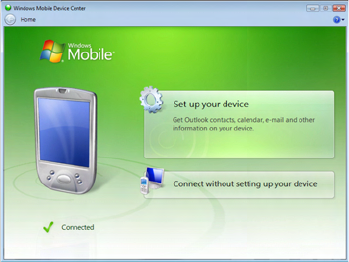
54 Synchronizing Information With Your Computer
5.1 About Synchronization
You can take information from your computer wherever you go by synchronizing them to your device. The
following types of information can be synchronized between your computer and your device:
Microsoft® Office Outlook® information, which include Office Outlook e-mail, contacts, calendar,
tasks, and notes
Notes, which are created using Microsoft® Office OneNote® 2007
Media, such as pictures, music, and video
Favorites, which are the bookmarked links to your favorite Web sites
Files, such as documents and other files
Before you can synchronize, you need to install and set up first the synchronization software on your
computer. For more information, see “Setting Up Windows Mobile Device Center on Windows Vista®” and
“Setting Up ActiveSync® on Windows XP®” in this chapter.
Ways to synchronize
After you have installed the synchronization software on your computer, connect and synchronize your
device with your computer by:
Using the supplied USB sync cable.
Upon connecting the sync cable to your device and your computer, the synchronization process
automatically starts.
Using Bluetooth.
You must first set up a Bluetooth partnership between your device and your computer before you
can synchronize information between them using Bluetooth. For more information about setting up
a Bluetooth partnership, see Chapter 9. For information about synchronizing through Bluetooth, see
“Synchronizing via Bluetooth” later in this chapter.
Try to synchronize regularly in order to keep information up-to-date in both your device and your computer.
Note You can also synchronize Outlook e-mail, contacts, calendar, and tasks on your device with the Exchange Server
at your work. For more information about setting up your device to synchronize with the Exchange Server, see
Chapter 7.
5.2 Setting Up Windows Mobile® Device Center on Windows Vista®
Microsoft Windows Mobile® Device Center is the replacement for Microsoft® ActiveSync® on Windows Vista®.
Note Some versions of Windows Vista® come with Windows Mobile Device Center already installed. If Windows Mobile
Device Center is not available on your Windows Vista®, you can install it from the Getting Started Disc that came
with your device.
Set up synchronization in Windows Mobile Device Center
When you connect your device to your computer and start Windows Mobile Device Center for the first time,
you are asked to create a Windows Mobile partnership with your device. To create a partnership:
1. Connect your device to your computer. Windows Mobile
Device Center configures itself, then opens.
2. On the license agreement screen, click Accept.
3. On the Windows Mobile Device Center’s Home screen,
click Set up your device.
Note Choose Connect without setting up your device
if you only want to transfer media files, check for
updates, and explore your device but not synchronize
Outlook information.
4. Select the items you want to synchronize, then click Next.
5. Enter a device name, then click Set Up.
When you finish the setup wizard, Windows Mobile Device Center synchronizes your device automatically.
Notice that Outlook e-mails and other information appear on your device after synchronization.
•
•
•
•
•
•
•
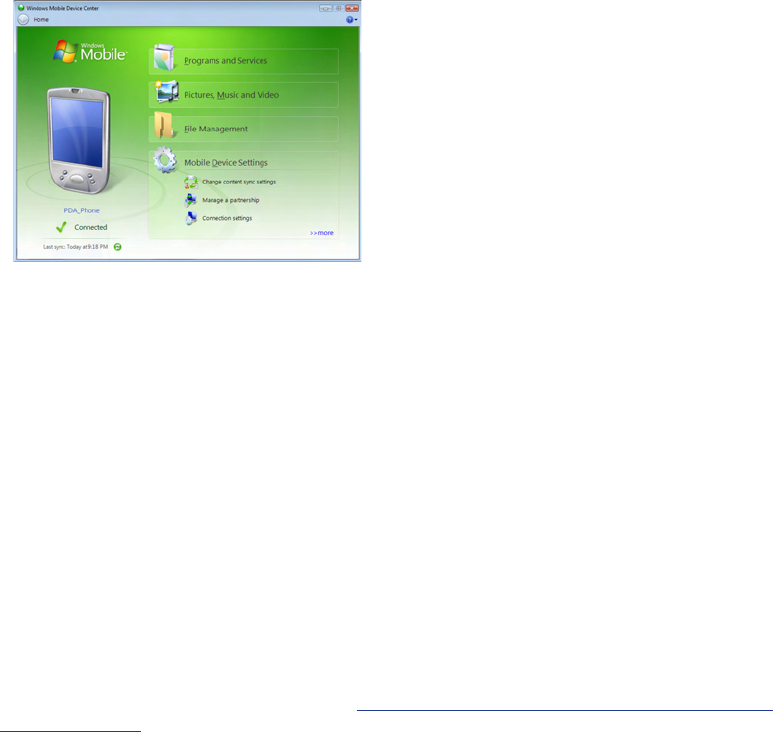
Synchronizing Information With Your Computer 55
Use Windows Mobile Device Center
To open Windows Mobile Device Center, click Start > All Programs > Windows Mobile Device Center on
your Windows Vista computer.
On Windows Mobile Device Center, you can do the following:
Click Mobile Device Settings to change synchronization settings.
When you click Pictures, Music and Video > XX new pictures/video clips are available for import, a
wizard guides you to tag and transfer photos from your device to the Photo Gallery on your computer.
Click Pictures, Music and Video > Add media to your device from Windows Media Player to
synchronize music and video files using Windows Media® Player. For more information, see “Using
Windows Media® Player Mobile” in Chapter 11.
Click File Management > Browse the contents of your device to view documents and files on your
device.
Note See Windows Mobile Device Center Help for more information.
5.3 Setting Up ActiveSync® on Windows XP®
The Getting Started disc that comes with your device contains Microsoft ActiveSync 4.5 or later. Follow the
steps in this section to install and set up ActiveSync on Windows XP or other compatible Windows systems.
Note For a list of compatible Windows systems, go to http://www.microsoft.com/windowsmobile/activesync/
activesync45.mspx.
Install ActiveSync
1. Place the Getting Started disc to the disc drive of your computer.
2. Click Setup and Installation.
3. Select the ActiveSync check box, then click Install.
4. Read the license terms, then click Accept.
5. When installation is completed, click Done.
6. On the Getting Started with Windows Mobile screen, click Close.
Set up synchronization in ActiveSync
1. Connect your device to your computer. The Synchronization Setup Wizard automatically starts and
guides you to create a synchronization partnership. Click Next to proceed.
2. To synchronize your device with your computer, clear the Synchronize directly with a server running
Microsoft Exchange check box, then click Next.
3. Select the information types that you want to synchronize, then click Next.
4. Select or clear the Allow wireless data connections check box according to your preference.
5. Click Finish.
When you finish the wizard, ActiveSync synchronizes your device automatically. Notice that Outlook e-mails
and other information appear on your device after synchronization.
•
•
•
•
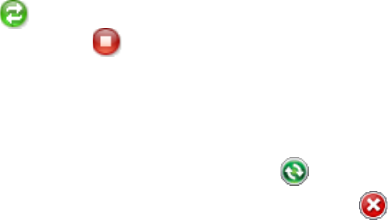
56 Synchronizing Information With Your Computer
5.4 Synchronizing With Your Computer
Connect and synchronize your device with your computer using the USB cable or Bluetooth connection.
Start and stop synchronization
You can manually synchronize either from your device or computer.
From your device
On the TouchFLO 3D Home screen, slide to the Settings tab and then touch Sync Data; or
Tap Start > Programs > ActiveSync, then tap Sync. To end synchronization before it completes, tap
Stop.
Tip To delete a partnership with one computer completely, disconnect your device from that computer first. In
ActiveSync on your device, tap Menu > Options, tap the computer name, then tap Delete.
From Windows Mobile Device Center
1. Click Start > All Programs > Windows Mobile Device Center.
2. Click at the lower left of the Windows Mobile Device Center. To end synchronization before it
completes, click .
From ActiveSync on your computer
When you connect your device to your computer, ActiveSync automatically opens on your computer and
synchronizes.
To manually start synchronization, click .
To end synchronization before it completes, click .
Change which information is synchronized
You can change the information types and the amount of information to synchronize for each type either on
your device or your computer. Follow the steps below to change synchronization settings on your device.
Note Before changing synchronization settings on your device, disconnect it from your computer.
1. In ActiveSync on your device, tap Menu > Options.
2. Select the check box for any items you want to synchronize. If you cannot select a check box, you might
have to clear the check box for the same information type elsewhere in the list.
3. To change synchronization settings for an information type, for instance, E-mail, select it and tap
Settings.
You can then set the download size limit, specify the time period of information to download, and more.
Notes • Some information types such as Favorites, Files and Media cannot be selected in ActiveSync Options on
your device. You can only select or clear these items from your computer’s Windows Mobile Device Center or
ActiveSync.
• A computer can have sync partnerships with many different Windows Mobile powered devices, but a device
can have sync partnerships with at most two computers. To ensure that your device will synchronize properly
with both computers, set up the second computer using the same synchronization settings you used on the first
computer.
• Outlook e-mail can be synchronized with only one computer.
Troubleshoot sync connection problem
In some cases, when the computer connects to the Internet or a local network, it may disconnect the
connection with your device in favor of the Internet or network connection.
If this happens, tap Start > Settings > Connections tab > USB to PC, then clear the Enable advanced
network functionality check box. This makes your computer utilize a serial USB connection with your device.
•
•
•
•
Synchronizing Information With Your Computer 57
5.5 Synchronizing via Bluetooth
You can connect and synchronize your device with the computer using Bluetooth.
Note To connect and synchronize your device with a computer via Bluetooth, your computer must have a built-in
Bluetooth or installed with a Bluetooth adapter or dongle.
To synchronize with a computer via Bluetooth
1. Set up Windows Mobile Device Center or ActiveSync on your computer to synchronize through
Bluetooth. See the program’s Help for instructions.
2. On your device, tap Start > Programs > ActiveSync.
3. Make sure that Bluetooth on both your device and the computer are turned on and set to visible mode.
See “Bluetooth Modes” in Chapter 9 for details.
If this is the first time you have connected to this computer via Bluetooth, you must first complete the
Bluetooth wizard on your device and set up a Bluetooth partnership between your device and the
computer. For more information about creating a Bluetooth partnership, see “Bluetooth Partnerships”
in Chapter 9.
4. Tap Menu > Connect via Bluetooth. Make sure the Bluetooth function of both your device and the
computer are turned on and set to visible mode.
Note To conserve battery power, turn off Bluetooth when not in use.
5.6 Synchronizing Music and Video
If you want to carry your music or other digital media along with you while you travel, set up Windows Media®
Player on your computer to synchronize music and video with your device.
Other than selecting the Media information type to be synchronized, all media synchronization settings must
be set in Windows Media® Player. Before media can be synchronized, you must do the following:
Install Windows Media® Player Version 11 on your computer. (Windows Media® Player 11 works only in
Windows XP or later versions).
Connect your device to the computer with a USB cable. If your device is currently connected using
Bluetooth, you must end that connection before media can be synchronized.
Set up a sync partnership between your device and your computer’s Windows Media® Player.
For more information about using Windows Media® Player Mobile, see Chapter 11.
•
•
•
58 Synchronizing Information With Your Computer

Chapter 6
Exchanging Messages
6.1 Messaging
6.2 Text Messages
6.3 Types of E-mail Accounts
6.4 E-mail Setup Wizard
6.5 Using E-mail
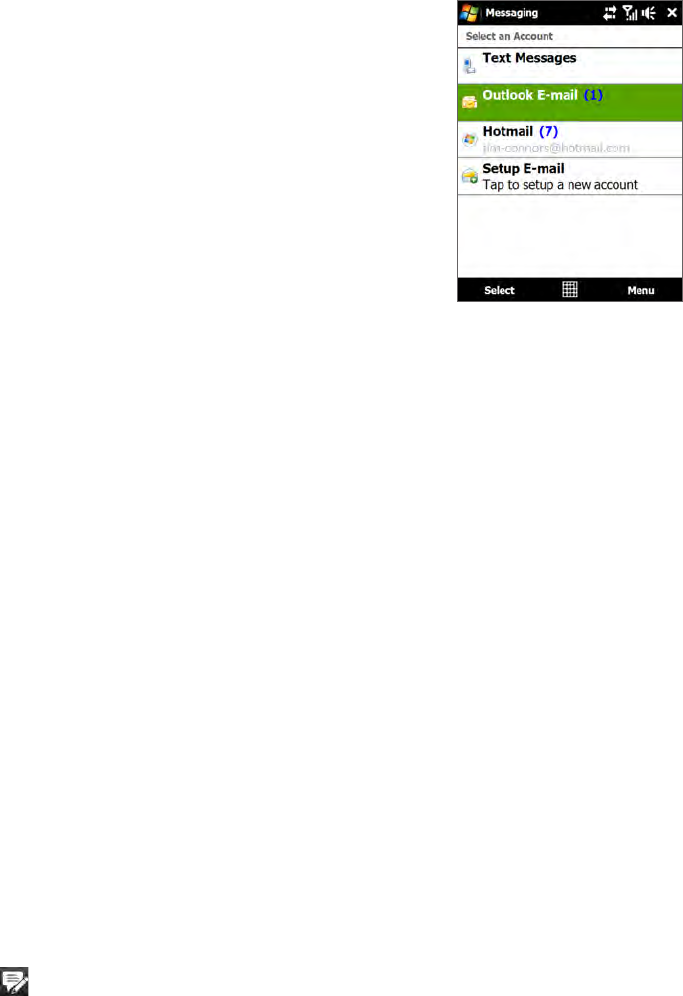
60 Exchanging Messages
6.1 Messaging
Messaging is a central location where you will find all types of messaging accounts, which include text
messages (SMS) and e-mail accounts.
To select a messaging account
Account Picker screen
Do one of the following:
On the TouchFLO 3D Home screen, slide to the Mail tab and then
touch Menu > Accounts > Accounts. The Account Picker screen then
opens where you can select an account.
Tip You can also tap Start > Messaging to access the Account Picker
screen.
While you are in a message list of a certain account, for example Text
Messages, tap Menu > Go To to switch to other types of messaging
accounts.
To configure message account settings
Tap Menu > Options on the Account Picker screen; or
Tap Menu > Tools > Options while you’re in a message list.
•
•
•
•
To automatically add a signature in outgoing messages
You can automatically add your name and other information as your signature in outgoing SMS and e-mail
messages:
Note You need to specify your signature for each type of messaging account.
1. Tap Start > Messaging, then tap Menu > Options.
2. Tap Signatures.
3. Select a messaging account in which to add a signature.
4. Select the Use signature with this account check box.
5. In the provided text box, enter the information that will be displayed as your signature.
6. If you want the signature to be added whenever you reply or forward messages, select the Use when
replying and forwarding check box, then tap OK.
7. Repeat the steps to add a signature to other messaging accounts.
6.2 Text Messages
Send short text messages (SMS) up to 160 characters long to other mobile phones.
Create a new text message
Depending on your preference, there are a number of alternative ways you can create a new text message.
From the TouchFLO 3D Home screen
1. On the Home screen, slide to the Messages tab.
2. Touch the New icon ( ) on the upper right side of the screen.
Tip To send a text message to a favorite contact, first select the photo of the desired contact in the People tab to open
his or her contact card and then touch Send text message. For more information about working with favorite
contacts, see “People” in Chapter 3.
From the Account Picker screen
1. Tap Start > Messaging > Text Messages.
2. Tap Menu > New.
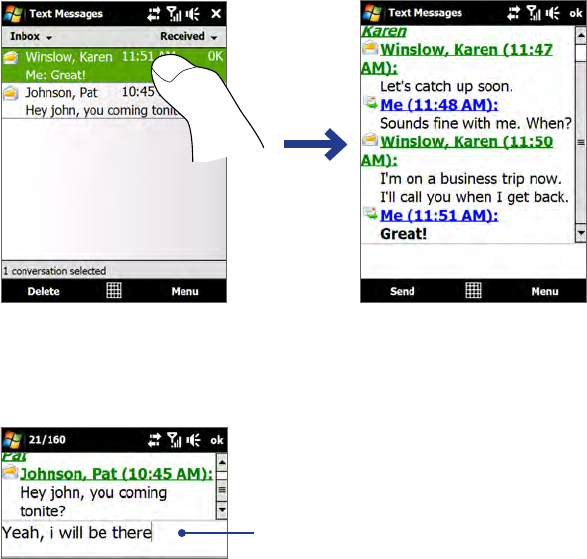
Exchanging Messages 61
From the Contacts screen
1. Tap Start > Contacts.
2. Tap the contact’s name to open his or her contact card.
3. Touch Send text message.
Compose and send a text message
After creating a new text message, follow the steps below to enter your message and then send it.
1. To add recipients,
enter their mobile phone numbers in the To field, separating them with a semicolon.
Y
ou can also tap To or tap Menu > Add Recipient to add mobile phone numbers from Contacts..
2. Enter your message.
Tip To choose from preset messages, tap Menu > My Text and tap a desired message. To check the
spelling, tap Menu > Spell Check.
3. Tap Send.
Tips • For more information about entering text and symbols, see Chapter 4.
• If you want to know when a text message is received, before sending the message that you are composing, tap
Menu > Message Options, then select the Request message delivery notification check box.
• To always receive a delivery notification, tap Menu > Tools > Options in the text message list, tap Text
Messages, then select the Request delivery notifications check box.
Manage text messages
Text messages that are sent to and received from a contact (or number) are grouped as a single thread in
your inbox. Threaded SMS lets you see exchanged messages (similar to a chat program) with a contact on the
screen.
To reply to a text message
1. In the Text Messages inbox, tap a message thread to open it.
2. At the bottom of the screen, type your reply message and then tap Send.
Enter your reply message here
To delete a message in the thread
1. In the Text Messages inbox, tap a message thread to open it.
2. Use the Navigation Up or Down control to select a message in the thread that you want to delete.
3. Tap Menu > Delete.
62 Exchanging Messages
To delete all messages in a thread
1. In the Text Messages inbox, select a message thread using the Navigation Up or Down control.
2. Tap Delete.
6.3 Types of E-mail Accounts
You can set up the following types of e-mail accounts on your device:
Outlook e-mail that you sync with your computer or the Exchange Server.
E-mail account that you have from an Internet Service Provider (ISP) or other e-mail provider.
Web-based e-mail accounts such as Gmail®, Yahoo!® Mail Plus, AOL®, and others.
Work account that you access using a VPN connection.
Set up your device to synchronize Outlook e-mail with the computer
If you have installed the synchronization software on your computer and created a partnership with your
device, then your device is ready to send and receive Outlook e-mail.
If you have not yet installed the synchronization software nor created a partnership, do so by following the
procedures in Chapter 5.
Tip To set up your company e-mail account so that you can access Outlook e-mail messages wirelessly, you must set
up your device to synchronize via an over-the-air connection with your company’s Exchange Server. For more
information about synchronizing with your company e-mail server, see Chapter 7.
Add an e-mail account
To add a new e-mail account, you can do one of the following:
On the TouchFLO 3D Home screen, slide to the Mail tab and then touch Menu > Accounts > New
Account; or
Tap Start > Messaging > Setup E-mail.
The E-mail Setup wizard then opens and lets you enter your e-mail account settings. See “E-mail Setup Wizard”
in this chapter for details.
6.4 E-mail Setup Wizard
Windows Mobile’s E-mail Setup wizard walks you through the process of setting up your e-mail account. It
has an Auto Setup feature which can automatically set up your e-mail account based on the e-mail address
and password that you enter, if your e-mail provider settings are preconfigured on your device. If the settings
are not found on your device, Auto Setup then attempts to retrieve the settings online for which you may be
charged when your device connects to the Internet and downloads them. If it cannot find the e-mail settings
online, you need to enter them manually.
Note For more information about setting up your company Outlook e-mail account, see Chapter 7.
Set up an Internet e-mail account
Set up a POP3 or IMAP4 e-mail account on your device if you have an e-mail account from an Internet service
provider (ISP) or other e-mail service provider, or a Web-based account such as Gmail, Yahoo! Mail Plus,
or AOL. You can also add a work account that you access using a VPN server connection as a POP3/IMAP4
account.
1. Add a new e-mail account. See “Add an e-mail account” for instructions.
2. Enter your E-mail address and the Password for your e-mail account and select the Save password
option. Tap Next.
3. If e-mail provider settings are found preconfigured on your device, the E-mail Setup wizard shows a
successful message. Tap Next.
If the settings are not found on your device, select the Try to get e-mail settings automatically from
the Internet checkbox to find and download e-mail server settings from the Internet and then tap
Next.
•
•
•
•
•
•
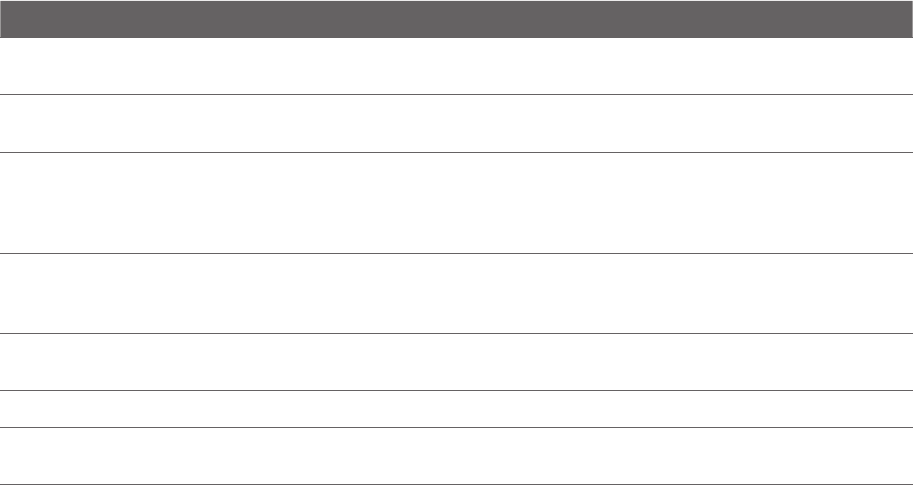
Exchanging Messages 63
4. Enter Your name and the Account display name and then tap Next.
Note If the E-mail Setup wizard was unsuccessful in finding and downloading settings from the Internet,
select Internet e-mail from the Your e-mail provider list on the next screen. You will be asked to enter
e-mail server settings. See “To specify e-mail server settings” for details.
5. In the Automatic Send/Receive list, choose how frequent you want e-mail messages to be
automatically sent and downloaded on your device.
Note Tap Review all download settings to select download options, set the e-mail format as HTML or plain
text, and more. For more information, see “To customize download and format settings."
6. Tap Finish.
To specify e-mail server settings
If Auto Setup is unsuccessful, contact your ISP or e-mail provider for the Incoming mail server and Outgoing
mail server settings so you can enter them on your device.
Other options that you can select include the following:
Select the Outgoing server requires authentication check box, if required by your provider.
If the outgoing e-mail server requires a different user name and password for sending e-mail, clear the
Use the same user name and password for sending e-mail check box. You will be prompted to enter
this information.
Tap Advanced Server Settings, then select the Require SSL check boxes if your e-mail provider
uses an SSL connection for more secured e-mail. From the Network connection list, select the data
connection that you use for connecting to the Internet.
To customize download and format settings
Before you tap Finish when setting up your POP3 or IMAP4 e-mail account, you can tap the Review all
download settings link at the bottom of the screen to choose download options, message format, and other
settings.
Options Description
Automatic Send/Receive You can select a time interval for connecting to the Internet automatically to
send and receive messages.
Download messages Set the number of days of messages that you want to be downloaded to your
device.
Send/receive when I click Send By default, messages are immediately delivered when you tap Send. If you prefer
to save outgoing messages to the Outbox folder first, clear the check box. (In
this case, you will need to manually send messages by tapping Menu > Send/
Receive).
Use automatic send/
receive schedule when roaming
This allows your device to data roam when there is a set time interval for
connecting to the Internet automatically. Since this may result in higher
connection costs, you may want to leave the check box cleared.
When deleting messages Choose whether to delete messages from the mail server when you delete them
on your device.
Message format Select HTML or Plain Text.
Message download limit Select the e-mail download size. If you have large volumes of e-mail, use a lower
size or select to download headers only.
•
•
•

64 Exchanging Messages
Set up a custom domain e-mail
When you are using an e-mail domain name that is hosted by a different e-mail provider (for example, your
e-mail address may be Benjamin@startup.com but Email.com hosts the e-mail account and provides e-mail
services), select the Custom Domain option in the E-mail Setup wizard to set up your e-mail account on your
device.
1. Add a new e-mail account. See “Add an e-mail account” for instructions.
2. Enter your E-mail address and the Password for your e-mail account and select the Save password
option. Tap Next.
3. Clear the Try to get e-mail settings automatically from the Internet and then tap Next.
4. In Your e-mail provider, select Custom domain and then tap Next.
5. Enter the domain of your e-mail provider and then tap Next.
6. The E-mail Setup wizard then tries to find the e-mail provider settings on your device or from the
Internet. If the settings are found, it shows a successful message. Tap Next.
7. Enter Your name and the Account display name and then tap Next.
Note If the E-mail Setup wizard was unsuccessful in finding the settings, you will be prompted to enter
e-mail server settings on the succeeding screens. See “To specify e-mail server settings” for details.
8. In the Automatic Send/Receive list, choose how frequent you want e-mail messages to be
automatically sent and downloaded on your device.
Note Tap Review all download settings to select download options, set the e-mail format as HTML or plain
text, and more. For more information, see “To customize download and format settings."
9. Tap Finish.
6.5 Using E-mail
After setting up e-mail accounts on your device, you can start sending and receiving e-mail messages.
Create a new e-mail message
Depending on your preference, there are two ways you can create a new e-mail message.
To start from an empty message
1. On the TouchFLO 3D Home screen, slide to the Mail tab.
2. Select the e-mail account you want to use on the right side of the screen.
Tip To choose from other e-mail accounts that are not displayed on the Mail tab, touch Menu > Accounts
> Accounts and then select an e-mail account from the Account Picker screen.
3. Touch the New Mail icon ( ) to create a new e-mail.
To send an e-mail to a favorite contact
1. On the TouchFLO 3D Home screen, slide to the People tab.
2. Swipe your finger on the screen to flip through the photos of your favorite contacts.
3. When the photo of the desired contact is displayed, touch the displayed photo and then touch Send
e-mail.
For more information about working with favorite contacts, see “People” in Chapter 3.
Tip You can also touch Start > Contacts, select a contact name, and then touch Send e-mail.
Compose and send an e-mail
After creating a new e-mail, follow the steps below to enter your message and then send it.
1. To add recipients, enter their e-mail addresses, separating them with a semicolon. You can also tap To if
you want to add e-mail addresses stored in Contacts.
2. Enter a subject and compose your message.
Tip To choose from preset messages, tap Menu > My Text and tap a desired message. To check the
spelling, tap Menu > Spell Check.
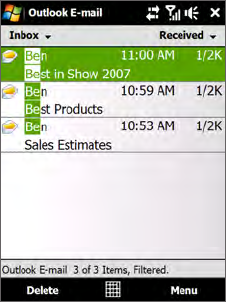
Exchanging Messages 65
3. Tap Send.
Tips • For more information about entering text and symbols, see Chapter 4.
• To set the message priority, tap Menu > Message Options.
• If you are working offline, e-mail messages are moved to the Outbox folder and will be sent the next time you
connect.
To add an attachment to a message
1. In the message that you are composing, tap Menu > Insert and tap the item you want to attach:
Picture, Voice Note, or File.
2. Select the file or picture you want to attach, or record a voice note.
Filter the Inbox message list
When the Inbox on your device is full of messages, you can filter your Inbox to display only the messages that
contain a particular sender or subject you are searching for.
To filter your Inbox
Enter the sender name or e-mail subject you want to look for. As you type characters, the message list narrows
down to the sequence of characters you have entered.
For example, entering “B”, then “E” narrows the list to only the e-mails that contain sender names and e-mail
subjects that start with “BE.”
View and reply to messages
To download a complete e-mail
By default, each e-mail received in the inbox on your device contains only the first few kilobytes of the
message. When you open an e-mail, it displays only the headers and part of the message. You must download
the whole e-mail to view the complete content.
To download a complete e-mail message, open the e-mail and then do one of the following:
Finger-scroll to the end of the message, and tap Get entire message and any attachments (POP3 e-
mail account) or tap Get the rest of this message (IMAP4 and Outlook e-mail accounts).
Tap Menu > Download Message.
Notes • The Fetch Mail feature, which is available for POP3 and IMAP4 Internet e-mail accounts, downloads an entire
e-mail without the need for you to perform a full synchronization. This limits the download to just the e-mail
message that you want and helps save data cost. Fetch Mail is also available for Outlook E-mail. See “Instant
download through Fetch Mail” in Chapter 7 for details.
• Download may take some time, depending on the speed of your Internet connection, size of the whole
e-mail, and whether file attachments are automatically downloaded.
•
•
66 Exchanging Messages
To download file attachments
POP3 e-mail account: File attachments of a POP3 Internet e-mail account are automatically
downloaded when you download a complete e-mail.
IMAP4 and Outlook e-mail accounts: File attachments appear below the subject of an e-mail
message. Tapping an attachment opens the attachment if it has been fully downloaded or marks it for
download the next time you send and receive e-mail.
You can set automatic download of file attachments. See “Customize e-mail settings” in this chapter for
details.
To reply to or forward a message
1. Open the message and tap Menu > Reply, Menu > Reply All, or Menu > Forward.
2. Enter your response, then tap Send.
Notes • You can receive and view HTML e-mails from any type of e-mail account. The HTML format is retained, without
layout shifting or resizing. HTML e-mail support in Outlook Mobile is available only if you are synchronizing your
device with Microsoft Exchange Server 2007.
• When replying using an Outlook e-mail account, you can customize ActiveSync to exclude addresses, including
your own, from being added to the recipient list. Tap Menu > Options in ActiveSync, select the E-mail item, tap
Settings, then tap Advanced. In the My e-mail addresses text box, enter e-mail addresses you want to exclude.
Synchronize e-mails
Synchronizing e-mails ensures that new e-mails are downloaded to the device Inbox folder, e-mails in the
Outbox folder are sent, and e-mails deleted from the server are removed from your device. The manner in
which you synchronize e-mails depends on the type of e-mail account you have.
To automatically synchronize an Outlook e-mail account
1. Connect your device to your computer through USB or Bluetooth. Otherwise, connect through Wi-
Fi or a data connection if you are synchronizing Outlook e-mail with the Exchange Server. For more
information, see Chapter 7.
2. Synchronization automatically begins, and your device sends and receives Outlook e-mail.
To manually synchronize your Outlook or Internet e-mail account
1. Select your Internet e-mail account. (See “To select a messaging account” in this chapter.)
2. Tap Menu > Send/Receive.
Customize e-mail settings
To change the download size and format for Outlook e-mail
1. Disconnect your device from the computer.
2. Tap Start > Programs > ActiveSync.
3. Tap Menu > Options, select E-mail, then tap Settings.
4. On the E-mail Sync Options screen:
Under Message format, select HTML or Plain text.
Under Download size limit, select the desired e-mail size.
5. Close ActiveSync and reconnect your device to the computer.
To change the download size and format for Internet e-mail
1. Tap Menu > Options on the Account Picker screen, or tap Menu > Tools > Options while you’re in a
message list.
2. Tap your POP3 or IMAP4 Internet e-mail account.
3. Tap Download Size Settings.
Under Message format, select HTML or Plain text.
Under Download size limit, select the desired e-mail size.
4. Tap Done.
•
•
•
•
•
•

Exchanging Messages 67
To automatically receive attachments on Outlook e-mails
1. Tap Start > Programs > ActiveSync.
2. Tap Menu > Options.
3. Tap E-mail > Settings, then select Include file attachments.
To automatically receive attachments on IMAP4 e-mails
1. Tap Menu > Options on the Account Picker screen, or tap Menu > Tools > Options while you’re in a
message list.
2. Tap the name of your IMAP4 e-mail account.
3. Tap Download Size Settings.
4. In Download attachments, select a download size or select All attachments.
5. Tap Done.
To store attachments on the internal storage
1. Tap Start > Messaging.
2. Tap Menu > Options > Storage tab.
3. Select the When available, use this storage card to store attachments check box.
68 Exchanging Messages

Chapter 7
Working With Company E-mails
and Meeting Appointments
7.1 Synchronizing with the Exchange Server
7.2 Working With Company E-mails
7.3 Managing Meeting Requests
7.4 Finding Contacts in the Company Directory
70 Working With Company E-mails and Meeting Appointments
7.1 Synchronizing with the Exchange Server
To keep up-to-date with your company e-mails and meeting schedules while you’re out of the office, you can
connect your device to the Internet through Wi-Fi or a data connection and synchronize with your company’s
Exchange Server.
Set up an Exchange Server connection
Before you can synchronize or access information on the Exchange Server, you need to set up an Exchange
Server connection on your device. You need to get the following information from your network administrator
and enter them on your device:
Exchange Server name (must be Outlook Web Access server name)
Domain name
User name and password that you use at work
If you have not synchronized your device with your computer, follow these steps to set up an Exchange Server
connection.
1. Add a new e-mail account. See “Add an e-mail account” in Chapter 6 for instructions.
2. Enter the E-mail address and Password for the e-mail account and select the Save password option.
Tap Next.
3. Clear the Try to get e-mail settings automatically from the Internet option and tap Next.
4. In Your e-mail provider, select Exchange server and tap Next.
5. Tap Next again.
6. Select the Attempt to detect Exchange Server Settings automatically option and tap Next.
7. Enter the Domain name and tap Next.
8. In Server address, enter the Exchange Server address and tap Next.
9. Select the items that you want to sync with the Exchange Server.
Tips • To change synchronization settings of an information item, for example, E-mail, select the item, then
tap Settings.
• To change the rules for resolving synchronization conflicts, tap Menu > Advanced.
10. Tap Finish.
Notes • If you synchronized e-mails with your computer before, open ActiveSync on your device, then tap Menu >
Add Server Source to set up an Exchange Server connection. When prompted to select information types for
synchronization, you must first clear the E-mail check box under the Windows PC item before you can select E-
mail under Exchange Server.
• To change Exchange Server settings, open ActiveSync on your device, then tap Menu > Configure Server.
Start synchronization
Before you start synchronizing with the Exchange Server, make sure your device has been set up with a Wi-
Fi or data connection to the Internet so that you can synchronize over the air. For more information about
connections, see Chapter 8.
After you finish setting up an Exchange Server connection, your device automatically starts synchronization.
To manually start synchronization, you can do one of the following:
On the TouchFLO 3D Home screen, slide to the Settings tab and then touch Sync Data; or
Tap Start > Programs > ActiveSync and then tap Sync.
Note If you connect your device to your office computer via a USB or Bluetooth connection, you can use this connection
to the computer to “pass through” to the network and download Outlook e-mails and other information to your
device.
•
•
•
•
•
Working With Company E-mails and Meeting Appointments 71
7.2 Working With Company E-mails
Your device gives you instant access to your company e-mails and lets you manage your messages easier.
Direct Push, Fetch Mail, Remote e-mail search, and e-mail flags are just some of the tools you can use to
manage your e-mails.
Note Some messaging features depend on the Microsoft Exchange Server version used in your company. Check with
your network administrator for the availability of these features.
Automatic synchronization through Direct Push
Direct Push technology (push e-mail feature) enables you to receive new e-mails on your device as soon as they
arrive in your Inbox on the Exchange Server. Items such as contacts, calendar and tasks are also immediately
updated onto your device when these items have been changed or new entries have been added on the
Exchange Server. To make Direct Push work, you need to have a Wi-Fi or data connection on your device.
You need to perform a full synchronization between your device and the Exchange Server first before Direct
Push can be enabled.
Requirement The Direct Push feature works for your device only if your company is using Microsoft Exchange
Server 2003 Service Pack 2 (SP2) with Exchange ActiveSync or higher version.
You can turn on Direct Push in the Comm Manager or ActiveSync.
To turn on Direct Push in Comm Manager
1. To open the Comm Manager, slide to the Settings tab on the TouchFLO 3D Home screen and then
touch Communications.
2. On the Comm Manager screen, touch Microsoft Direct Push.
To turn on Direct Push in ActiveSync
1. Tap Start > Programs > ActiveSync and then tap Menu > Schedule.
2. Select As items arrive in the Peak times and Off-peak times boxes.
Note When Direct Push is off, you need to manually retrieve your e-mails.
Scheduled synchronization
If you do not want to use Direct Push, you can set a regular schedule for synchronizing Outlook e-mail and
information.
1. In ActiveSync on your device, tap Menu > Schedule.
2. Select a shorter time interval in the Peak times box for you to be able to receive e-mails more
frequently. (Peak times usually refer to your working hours when e-mail volume is high).
3. Select a longer interval in the Off-peak times box.
Tip To set the days and hours that make up your peak and off-peak times, tap the peak times link at the bottom of the
screen.
Instant download through Fetch Mail
The Fetch Mail feature downloads an entire e-mail immediately without the need for you to perform a full
Send/Receive action. This limits the download to just the e-mail message that you want and helps save data
cost.
Requirement Fetch Mail works for your device only if your company is using Microsoft Exchange Server 2007 or
higher.
1. On the TouchFLO 3D Home screen, slide to the Mail tab, select your Outlook account, and then tap
Inbox.
2. Open an e-mail message.
3. By default, only the first few words of the message is shown. To download the whole e-mail, finger-
scroll to the end of the message, then tap Get the rest of this message.
4. Wait for the remainder of the message body to download.
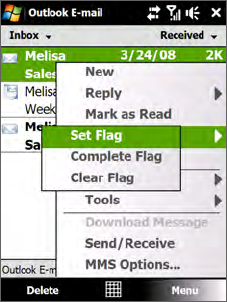
72 Working With Company E-mails and Meeting Appointments
Notes • For information about changing e-mail sync options such as setting the download size for e-mail, see "Customize
e-mail settings" in Chapter 6.
• When you receive an e-mail that contains a link to a document such as a PDF or Microsoft Office document
located on SharePoint or an internal file server, you can tap the link to view the document on your device. You
can view the document only if you have a Microsoft Outlook account that synchronizes with Microsoft Exchange
Server 2007 or later. Exchange Server must also be set up to allow access to SharePoint document libraries or
internal file servers.
Search for e-mails on the Exchange Server
You can access e-mails that are not available on your device by searching your Microsoft Exchange Server
mailbox. The search results are downloaded and displayed in a Search Results folder.
Requirement Your company must be using Microsoft Exchange Server 2007 or higher.
1. Tap Start > Messaging > Outlook E-mail.
2. Tap Menu > Tools > Search Server.
3. In the Look for text box, enter the search keyword.
4. Choose the date range of messages to search from.
5. In the Look in list, specify whether to search in the Inbox, Sent Items, or All Folders.
6. Tap Search.
Tip To clear the search results and return to the message list, tap Menu > Clear Results.
Flag your messages
Flags serve as a reminder for you to follow-up on important issues or requests contained in e-mail messages.
Flagging messages, which has been a useful feature on desktop Outlook E-mail, can also be done in Outlook
Mobile on your device. You can flag received e-mail messages on your device.
Requirement Flags are enabled only if e-mails are synchronized with Microsoft Exchange Server 2007 or higher.
Flags are disabled or hidden if e-mails are synchronized with earlier versions of Microsoft Exchange
Server.
To flag or unflag a message
1. Open Outlook on your device and access the Inbox.
2. Select a message or open a message.
3. Tap Menu > Follow Up and select one of the following options:
Set Flag Mark the message with a red flag to indicate that it needs follow up.
Complete Flag Mark the message with a check mark to indicate that the issue or request in the
e-mail is already completed.
Clear Flag Remove the flag to unmark the message.
Note E-mail message reminders are displayed on your device if the messages are flagged with reminders and
synchronized from the Exchange Server.
•
•
•
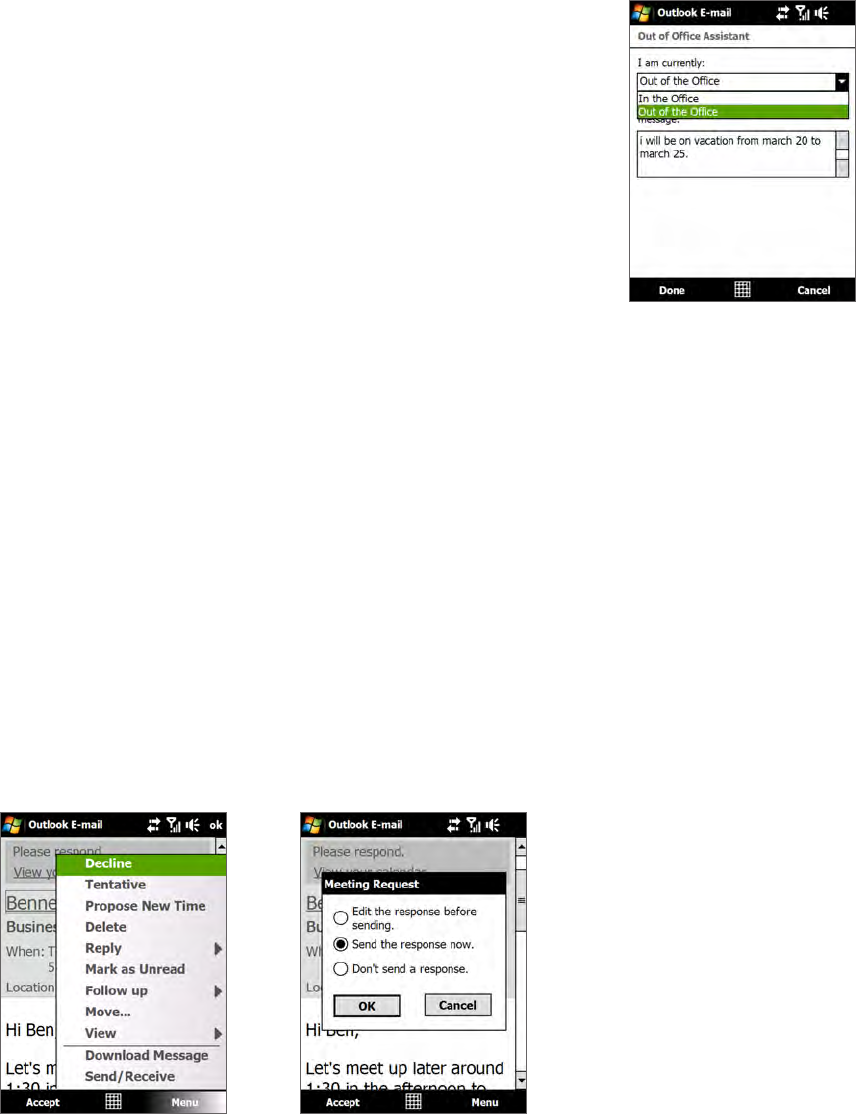
Working With Company E-mails and Meeting Appointments 73
Out-of-office auto-reply
Outlook Mobile allows you to retrieve and change your out-of-office status.
Just like desktop Outlook E-mail, Outlook Mobile automatically sends an
auto-reply message when you’re not available.
To send out-of-office auto-reply messages
1. Tap Start > Messaging > Outlook E-mail.
2. Tap Menu > Tools > Out of Office.
3. In the I am currently list, select Out of the Office.
4. Enter your auto-reply message, then tap Done.
7.3 Managing Meeting Requests
When you schedule and send meeting requests from your device, you can invite attendees to your meeting
and check their status to know about their availability.
When you receive a meeting request, you can reply by accepting or declining the request. The meeting
request also clearly indicates whether or not there are conflicting or adjacent meetings.
Requirement Your company must be using Microsoft Exchange Server 2007 or higher.
To reply to a meeting request
1. When you receive a meeting request e-mail, a notification will be displayed on your device. Open the
e-mail.
2. Tap Accept to reply and accept the meeting request, or tap Menu > Decline if you cannot attend the
meeting.
Tips • Before responding, you can check your availability during the time of the requested meeting by
tapping View your calendar.
• If the time of the meeting conflicts with your other appointments, a “Scheduling Conflict” status
appears on top of the e-mail.
3. Choose whether or not to edit your response e-mail before sending, then tap OK.
If you accepted the meeting request, it will automatically be added as an appointment in Calendar on your
device.
To view the list of meeting participants
1. Tap Start > Calendar.
2. Tap a meeting request that you sent and then tap Attendees. The required and optional attendees will
be listed.
Icons indicating whether each attendee has accepted or declined the meeting request will also be displayed.
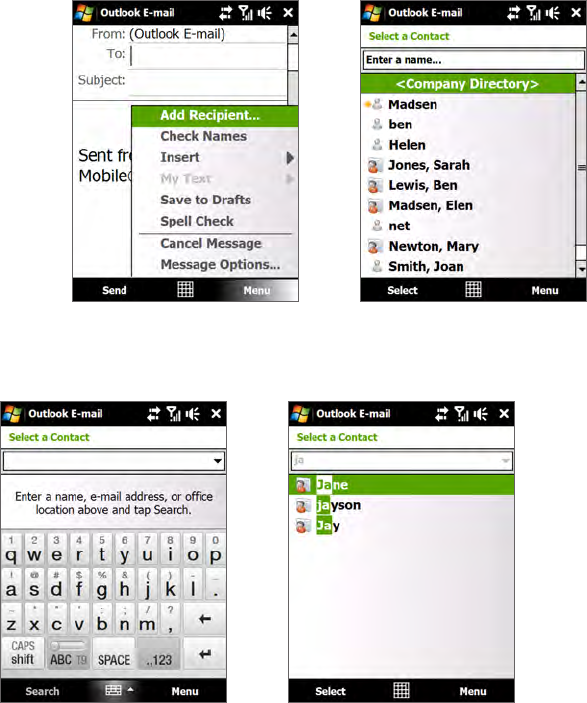
74 Working With Company E-mails and Meeting Appointments
Note To see the icon indicators in the attendees list, make sure Calendar is synchronized with the Exchange Server.
Tips • For information about creating a meeting request, see “To send a meeting request” in Chapter 12.
• To view an attendee’s contact information, tap the attendee’s name. If the attendee is included in your contacts
list, you will see the contact information immediately. If the attendee is not in your contacts list, tap Company
Directory to view the contact information.
7.4 Finding Contacts in the Company Directory
In addition to having contacts on your device, you can access contact information from your organization’s
Company Directory. By having over-the-air access to the Company Directory, you can easily send e-mail
messages and meeting requests to anyone in your company.
Requirement Access to the Company Directory is available only if your organization is running Microsoft Exchange
Server 2003 SP2 or higher, and you have completed your first synchronization with the Exchange
Server.
1. Synchronize with the Exchange Server.
2. Do any of the following:
In Contacts, tap Menu > Company Directory.
In a new e-mail message, tap the To box (or tap Menu > Add Recipient), then tap Company
Directory on the top of the list.
When creating a meeting request and selecting required and optional attendees in Calendar, tap
Company Directory.
2. Enter a partial or full contact name and tap Search. In the search results list, tap a contact to select it.
Note • You can save a contact from the Company Directory to your device by selecting the contact, then tapping Menu
> Save to Contacts.
• You can search on the following information as long as that information is included in the Company Directory:
First name, Last name, E-mail name, Display name, E-mail address, or Office location.
•
•
•
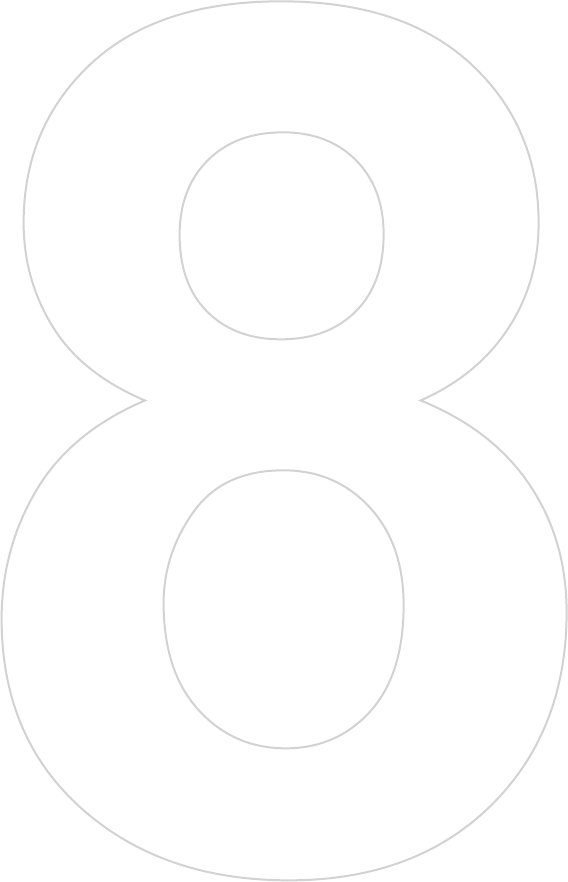
Chapter 8
Internet
8.1 Ways of Connecting to the Internet
8.2 Starting a Data Connection
8.3 Using Opera Mobile™
8.4 Using YouTube™
8.5 Using Windows Live™
8.6 Using Your Device As a Modem
(Wireless Modem)
8.7 Using RSS Hub
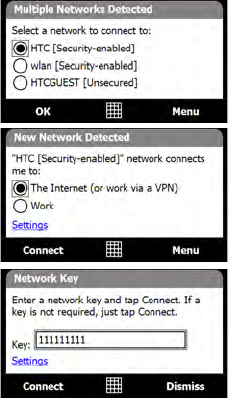
76 Internet
8.1 Ways of Connecting to the Internet
Your device’s networking capabilities allow you to access the Internet or your corporate network at work
through one of the following connections:
Wi-Fi
Dial-up
Note You can also add and set up the following connections:
• VPN: A VPN connection is used to access your corporate network by using an existing Internet connection.
• Proxy: A Proxy connection is used to access the Internet using an existing connection to your corporate or WAP
network.
Wi-Fi
Wi-Fi provides wireless Internet access over distances of up to 300 feet (100 meters).
To use Wi-Fi on your device, you need access to a wireless access point or “hotspot”.
Note The availability and range of your device’s Wi-Fi signal depends on the number, infrastructure, and other objects
through which the signal passes:
To turn Wi-Fi on and off
1. On the Home screen, slide to the Settings tab.
2. On the Settings screen, tap Communications > Wi-Fi to enable/disable the wireless function.
When enabled, the On indicator is activated and available wireless networks will be detected.
To connect to a wireless network
After Wi-Fi is turned on, your device scans for available wireless networks in your area.
1. The network names of the detected wireless networks are displayed on a
pop-up message window. Tap the desired wireless network, then tap OK.
Note When you select an open (unsecured) network, you will be
automatically connected to the network after tapping OK.
You do not need to do steps 2 and 3.
2. On the next pop-up message window, do one of the following:
Tap The Internet if the wireless network connects your device to the
Internet.
Tap Work if the wireless network connects your device to a private
network.
3. Enter the key and then tap Connect.
•
•
Next time you use your device to detect wireless networks, you will not see the pop-up message windows
again, and you will not be prompted to enter the network key of the previously accessed wireless network
(unless you perform a hard reset which will erase custom settings on your device).
Note Wi-Fi networks are self-discoverable, which means no additional steps are required for your device to connect to a
Wi-Fi network. It may be necessary to provide a username and password for certain closed wireless networks.
•
•
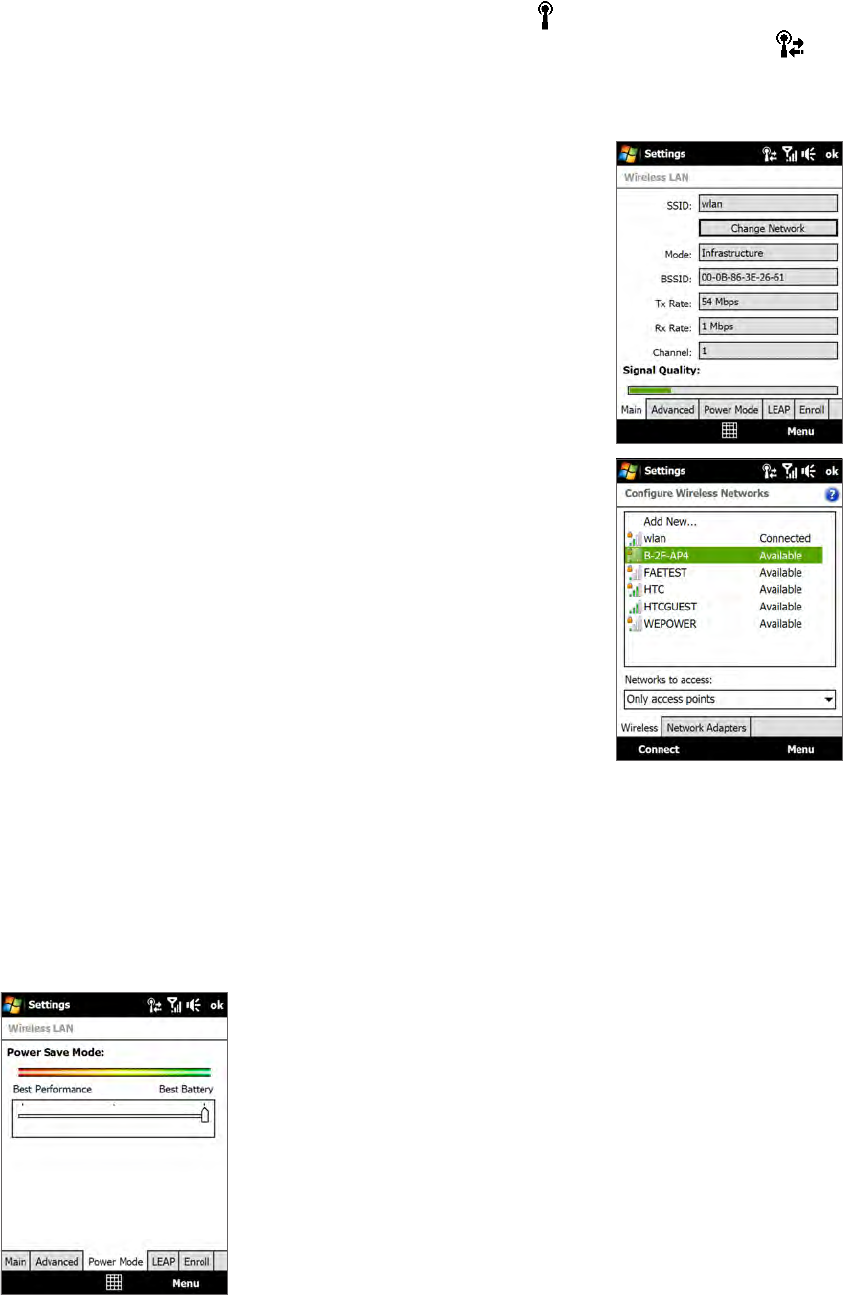
Internet 77
To check wireless network status
You can check the current wireless connection status from any of the following screens of your device:
Title bar. When you enable Wi-Fi on your device, the Wi-Fi ON icon appears on the title bar. After
Wi-Fi is turned on, your device scans for available wireless networks and the wireless signal icon
appears on the title bar. The arrows in this icon move back and forth while your device is scanning for a
wireless network signal. Once your device successfully connects to a wireless network, the arrows stop
moving.
Wireless LAN screen. On the Home screen, slide to the Settings tab
and then tap Menu > Wireless Networks. On the Main tab, you will
see the wireless network that your device is currently connected to.
The configuration and signal quality of the wireless network are also
shown.
•
Configure Wireless Networks screen. On the Home screen, slide
to the Settings tab and then tap All Settings. In the Connections
tab, tap Wi-Fi. This screen displays the wireless networks currently
available. To connect to a wireless network in the list, tap and hold on
the desired network, then tap Connect. Tap a wireless network in the
list to view or change its connection settings. You can also add new
wireless networks, if available, by tapping Add New.
•
To save battery power while connected to a wireless network
Using Wi-Fi quickly consumes battery power. Turn off Wi-Fi when not in use. You can also enable power saving
settings.
1. On the Home screen, slide to the Settings tab.
2. On the Settings screen, tap Menu > Wireless Networks > Power Mode tab.
3. On the Power Mode tab, move the Power Save Mode slider to a position that optimizes performance
with the least power consumption.
For example, move the slider to the left (Best Performance) to
have the optimal wireless network performance; move to the
right (Best Battery) to obtain the maximum battery usage.
•
78 Internet
8.2 Starting a Data Connection
After setting up a data connection on your device, you can now connect your device to the Internet. The
connection is started automatically when you begin using a program that accesses the Internet such as Opera
Mobile.
To manually start a data connection
If you have set up multiple types of data connections on your device, you can manually start a connection.
1. On the Home screen, slide to the Settings tab and then tap All Settings.
2. On the Connections tab, tap Connections.
3. Tap Manage existing connections.
4. Tap and hold the name of the desired connection, then tap Connect.
To disconnect active data connections
1. Tap Start > Settings > Connections tab > Comm Manager.
2. Tap the Data Connection button.
Note You cannot reconnect a data connection in Comm Manager.
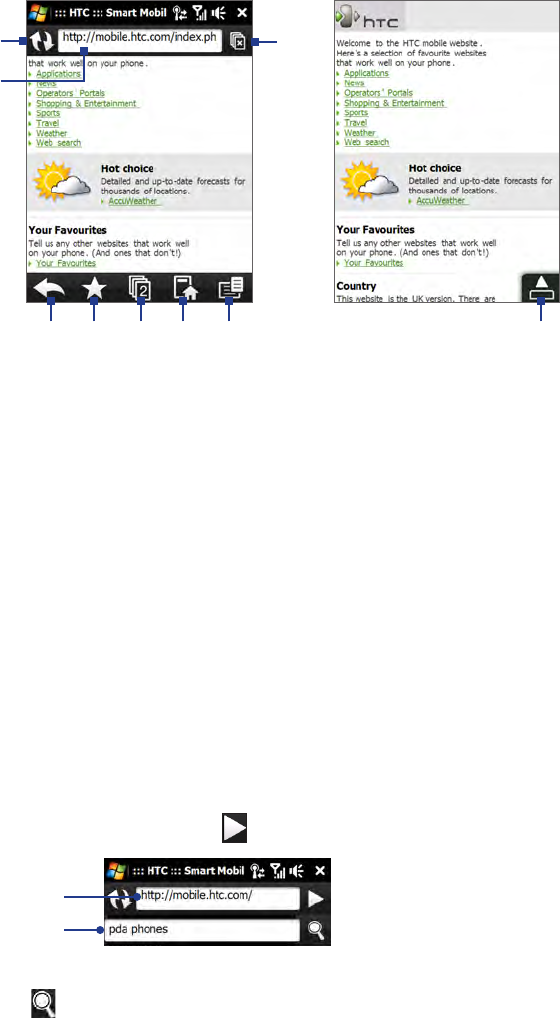
Internet 79
8.3 Using Opera Mobile™
Opera Mobile™ is a full-featured Internet browser, optimized for use on your device.
Note You can also use Internet Explorer® Mobile to browse the Web. To open Internet Explorer Mobile, tap Start >
Internet Explorer.
1
2
3 4 5 6 7
8
9
1Refresh. Tap to reload the Web page being viewed.
2Address bar. Enter the URL of the Web site here.
3Back. Tap to go back to the previous Web page viewed.
4Favorites. Tap to go to the Favorites screen where you can add a favorite, edit favorite Web pages, and
send the favorite URL link via one of the Messaging accounts.
5Tabs. Tap to add a new browsing tab or switch to another existing browsing tab.
6Home. Tap to go to the Home page.
7Menu. Tap to open a list where you can change Opera Mobile settings, check downloads, view History,
and more.
8Close tab. Tap to close the current tab. This is only enabled if you have more than one tab opened.
9Exit Full Screen mode. When browsing the Web, Opera Mobile automatically switches to Full screen
mode. Tap to show the address and Menu bars again.
To open Opera Mobile
On the Home screen, slide to the Internet tab and then tap Browser.
To go to a Web site
1. On the Opera Mobile screen, tap the address bar.
2. Enter the URL address and tap .
Search field
Address bar
Tip When you tap the address bar, a search field also appears. Quickly search the Web by entering the search item and
tapping .
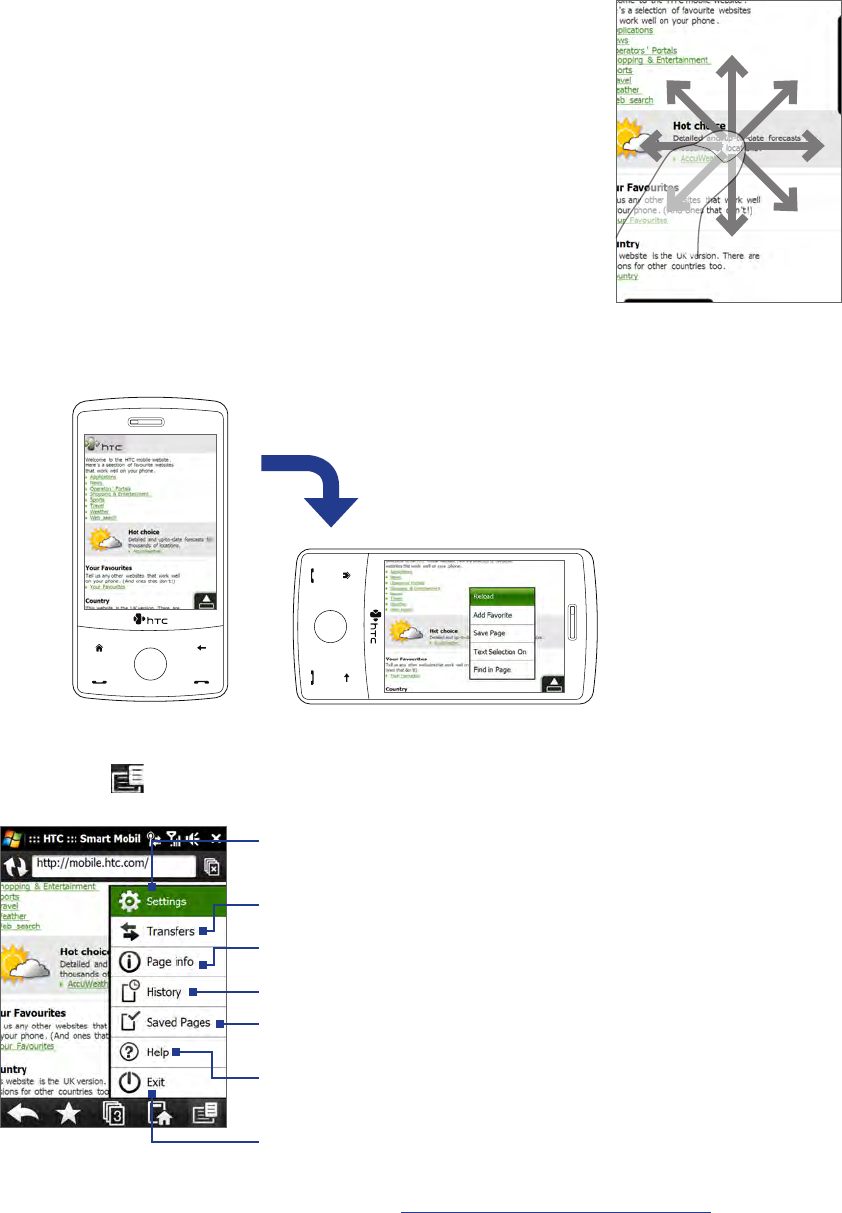
80 Internet
View Web pages
While browsing Web pages, use finger gestures to pan and zoom on the Web
page. To zoom in, tap your finger twice on the screen. To zoom out, tap your
finger twice on the screen again.
Tip Touch and hold an empty area on a Web page to open a shortcut menu that
lets you go back to the previous page, reload the page, add the page as a
Favorite, and more. You can also tap and hold a link or image on a Web page to
open a menu with different options.
To change the screen orientation
Change the screen orientation by simply turning your device sideways.
Opera Mobile menu
On the menu bar, tap to open the menu.
Tap to open the Settings screen where you
can set the default home page, change display
settings, set privacy settings, and more.
Tap to view items being downloaded. You can
also resume or stop current downloads.
Tap to view information about the Web page
you are browsing.
Tap to see web pages that you have viewed.
Tap to open the Opera Mobile help file.
Tap to close Opera Mobile completely.
Opera Mobile will not run in the background.
Tap to manage and view web pages that
you have saved.
Note For more information about using Opera Mobile, go to: http://www.opera.com/products/mobile/